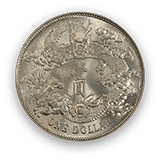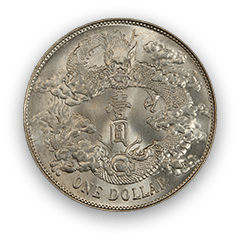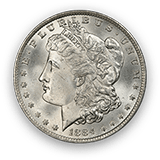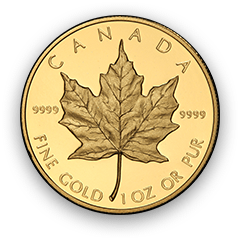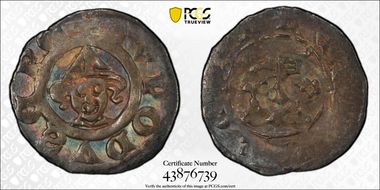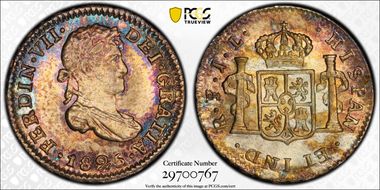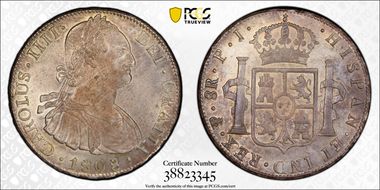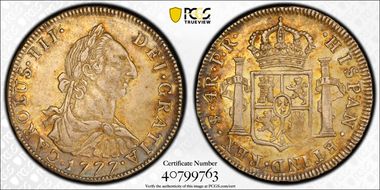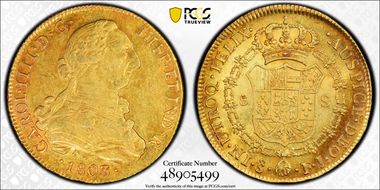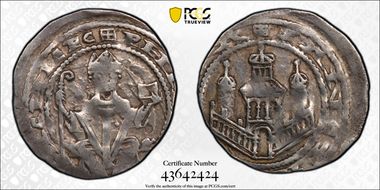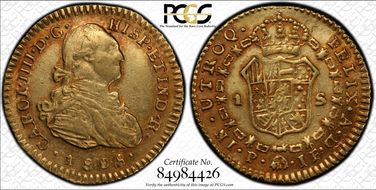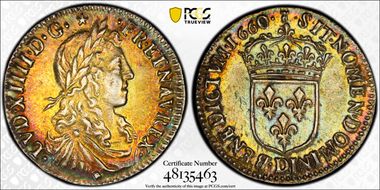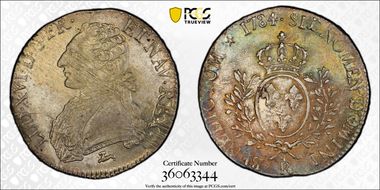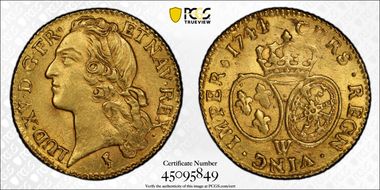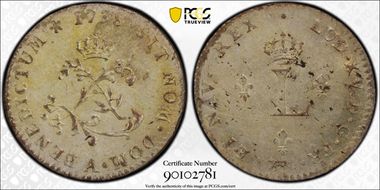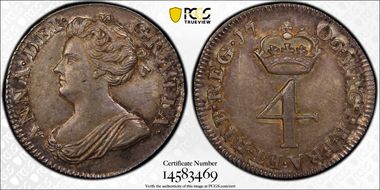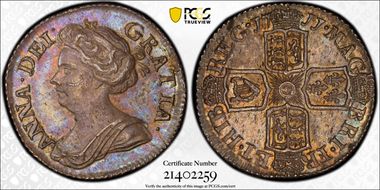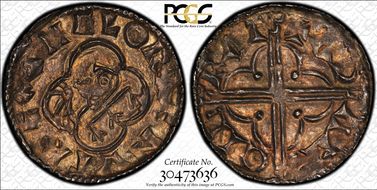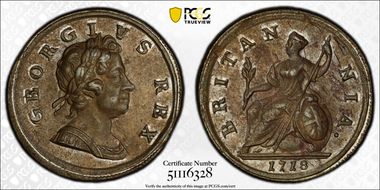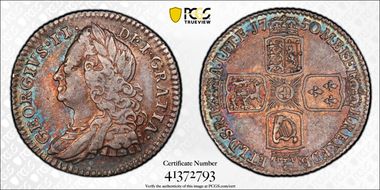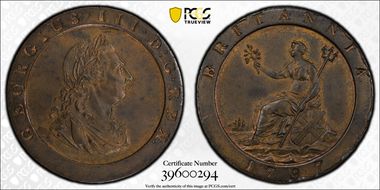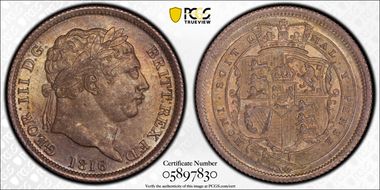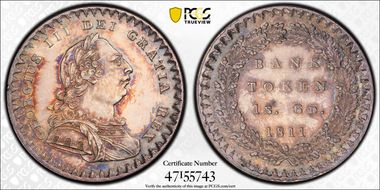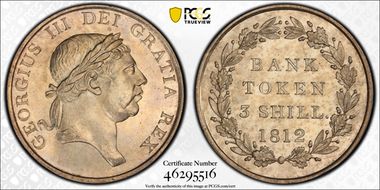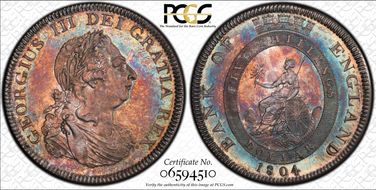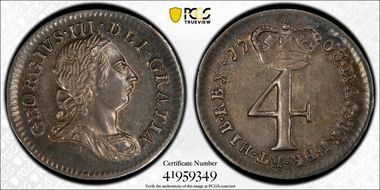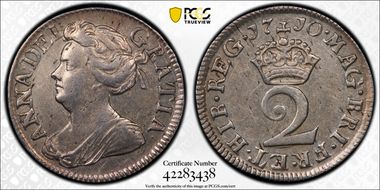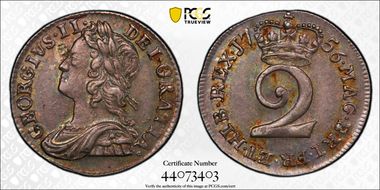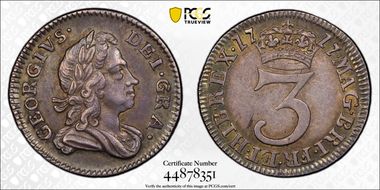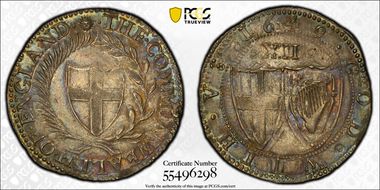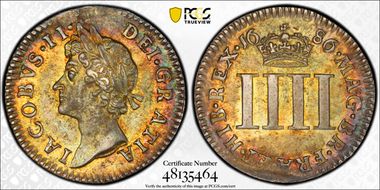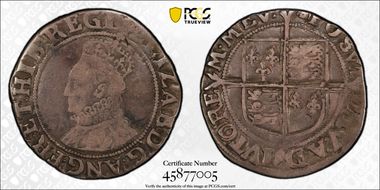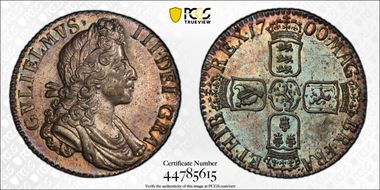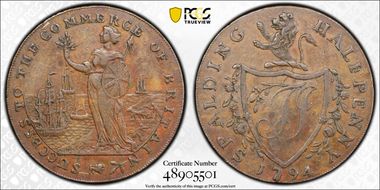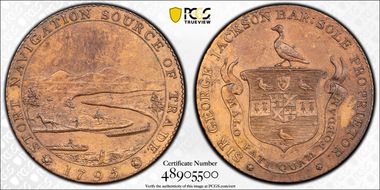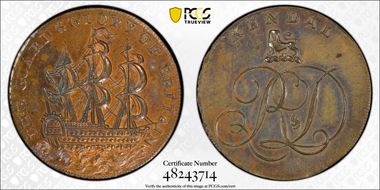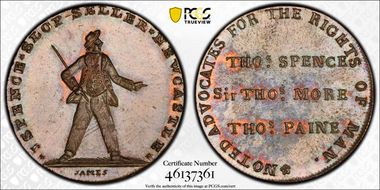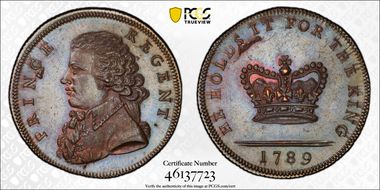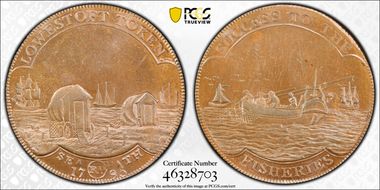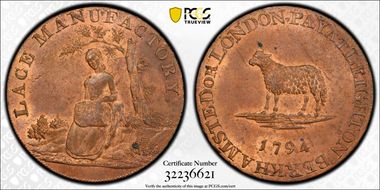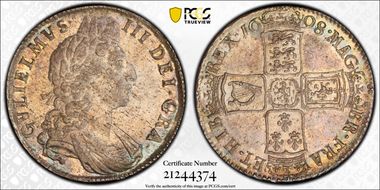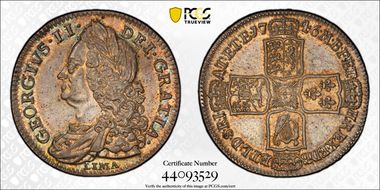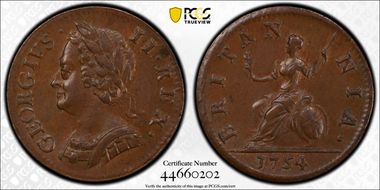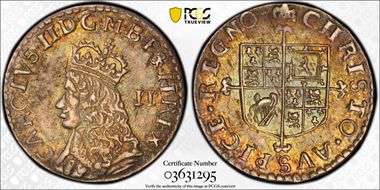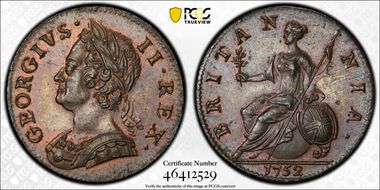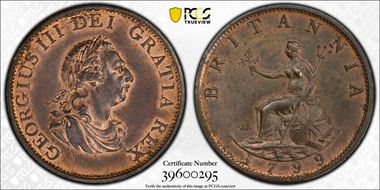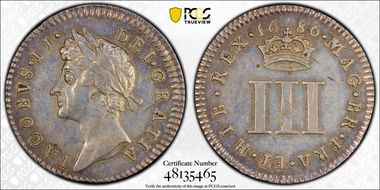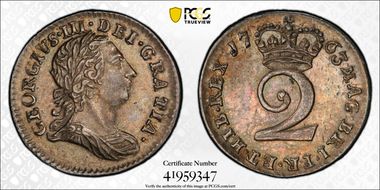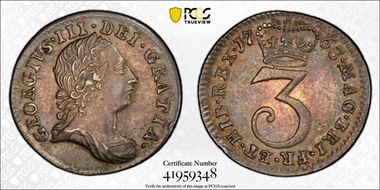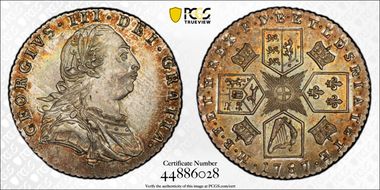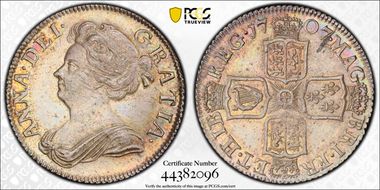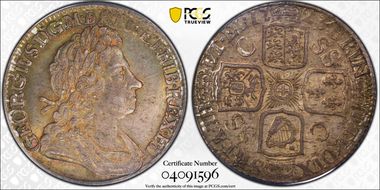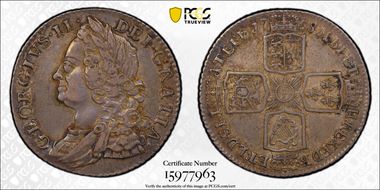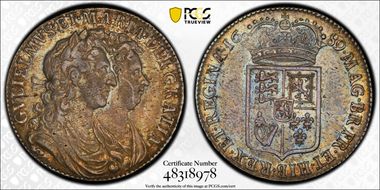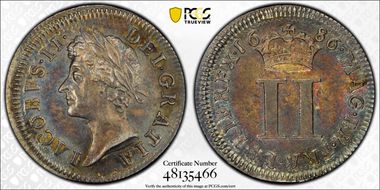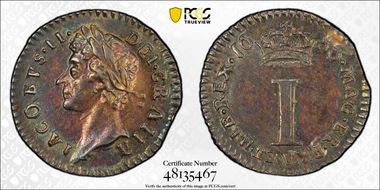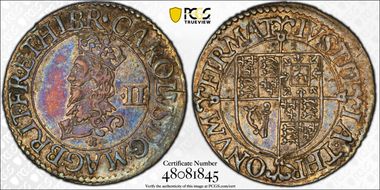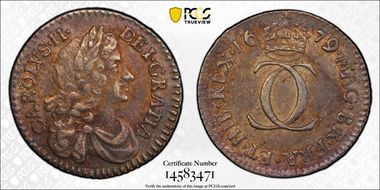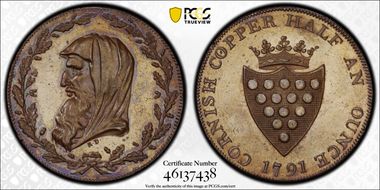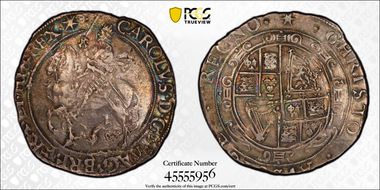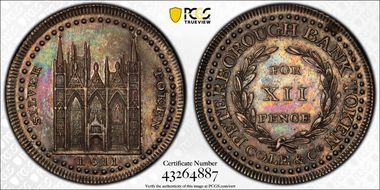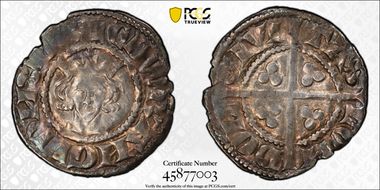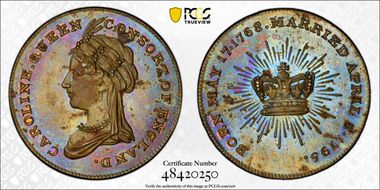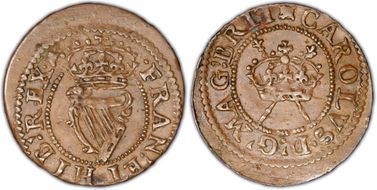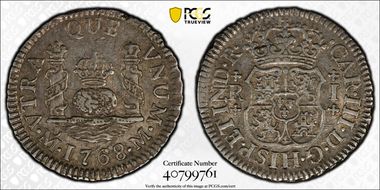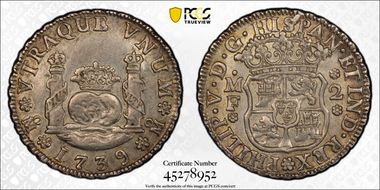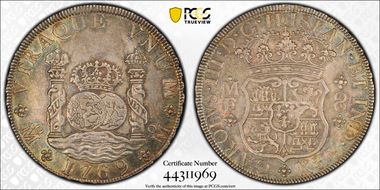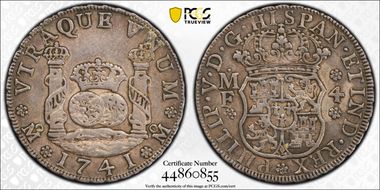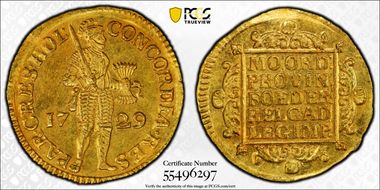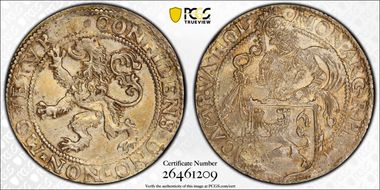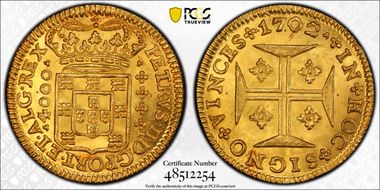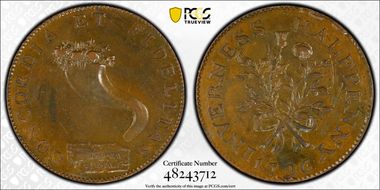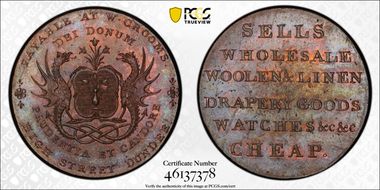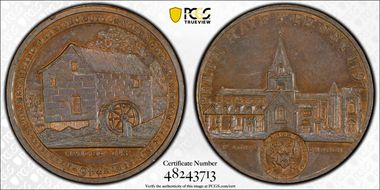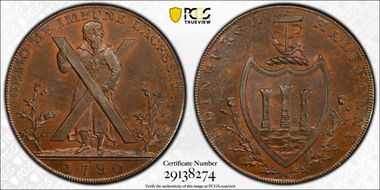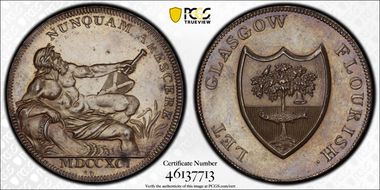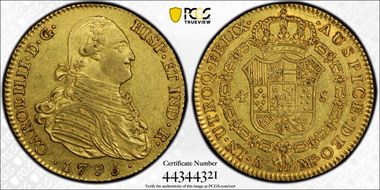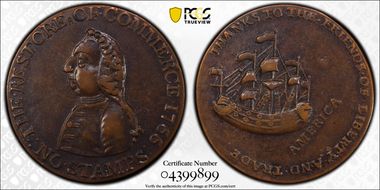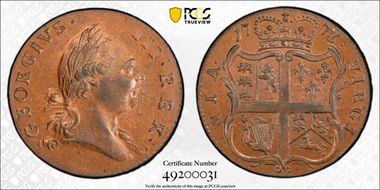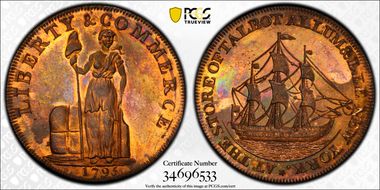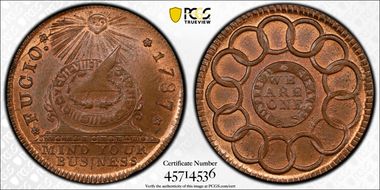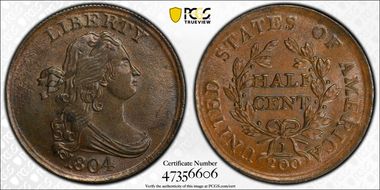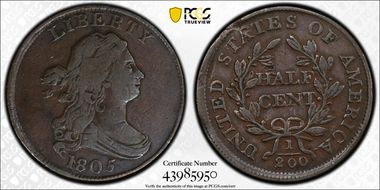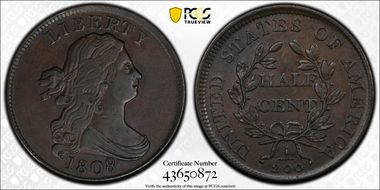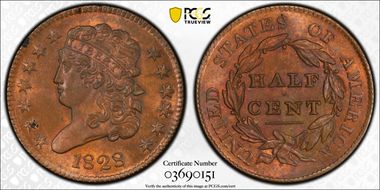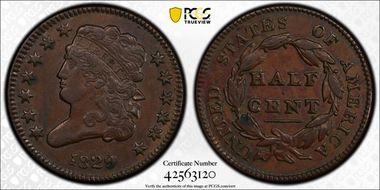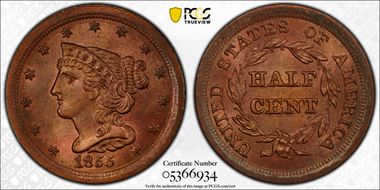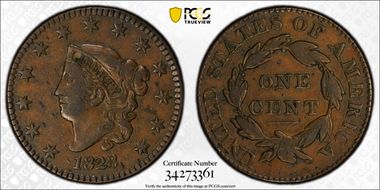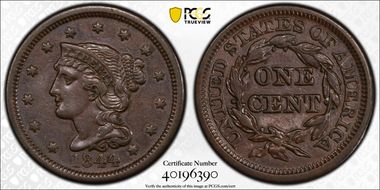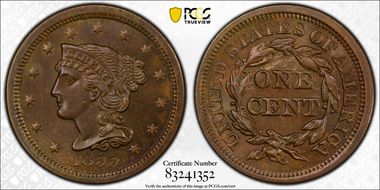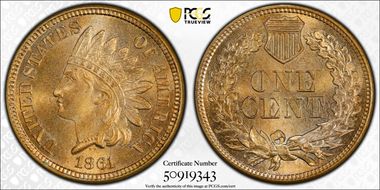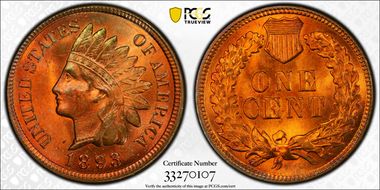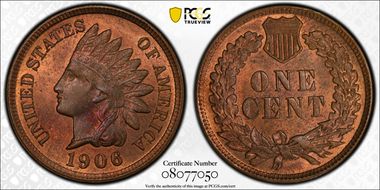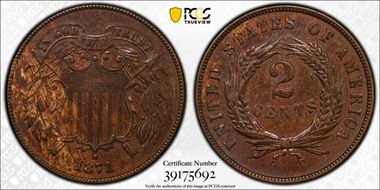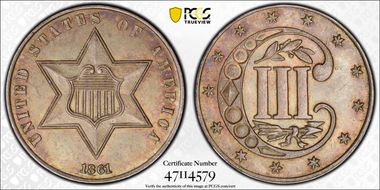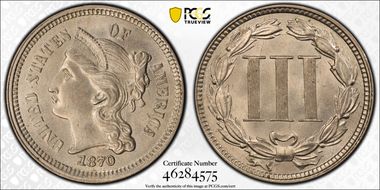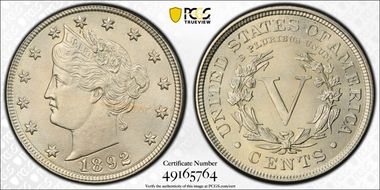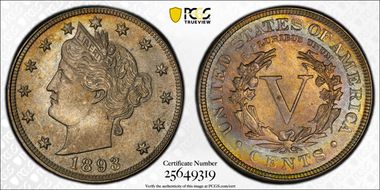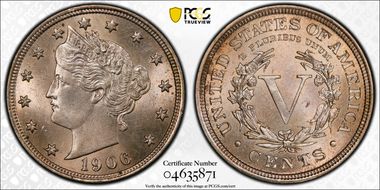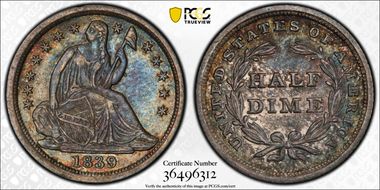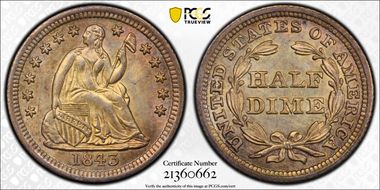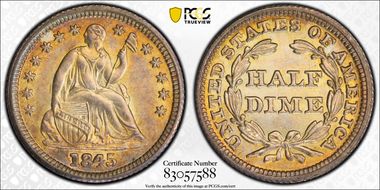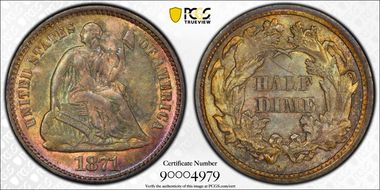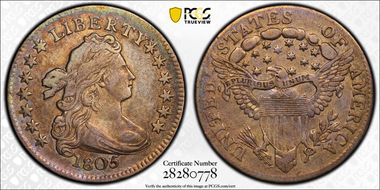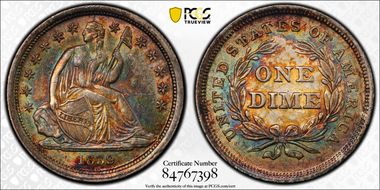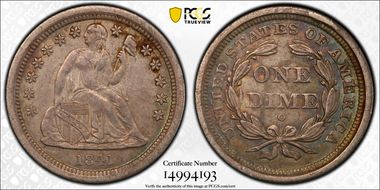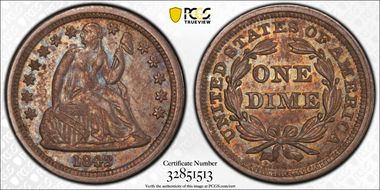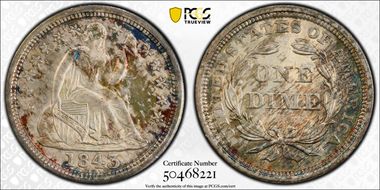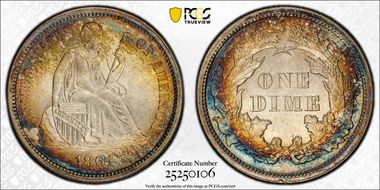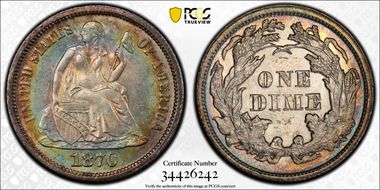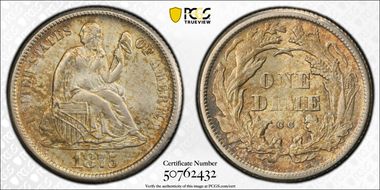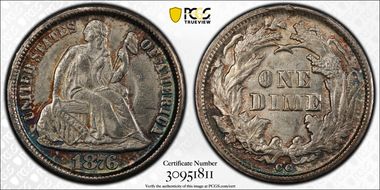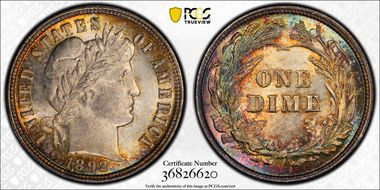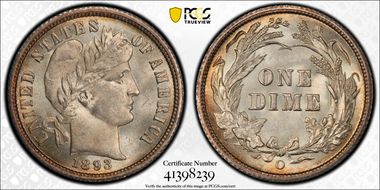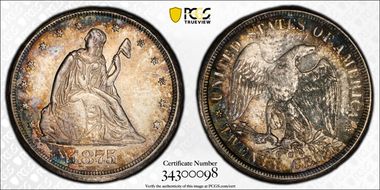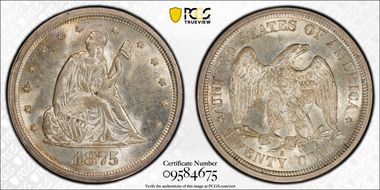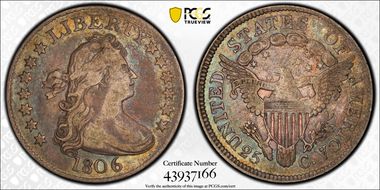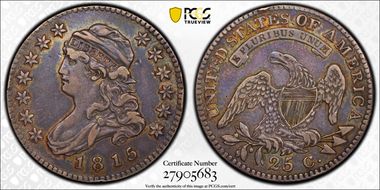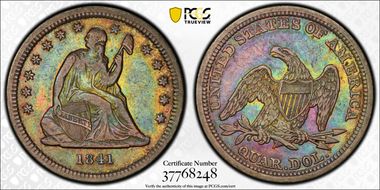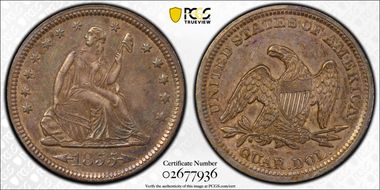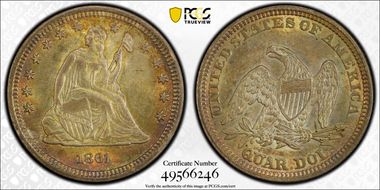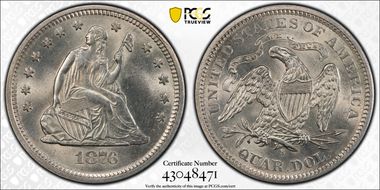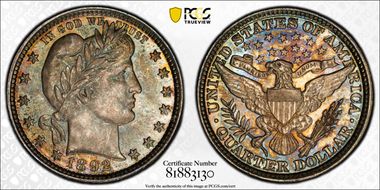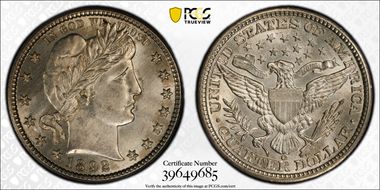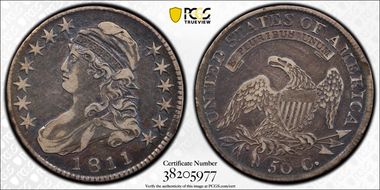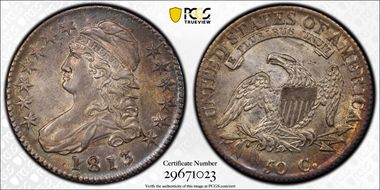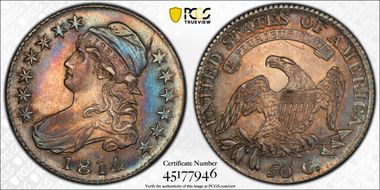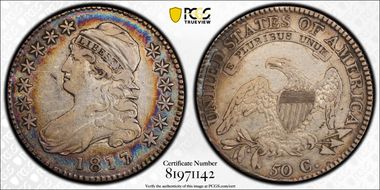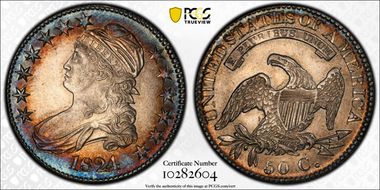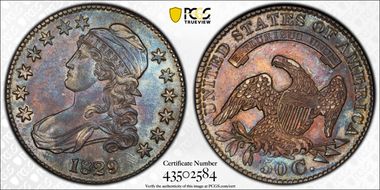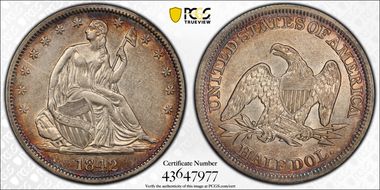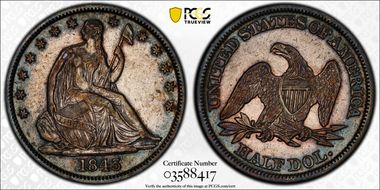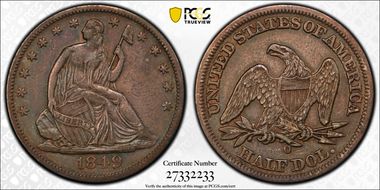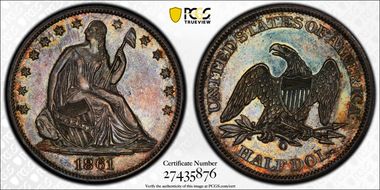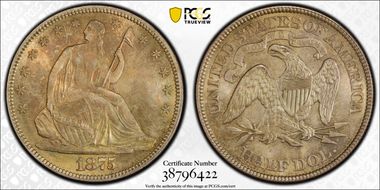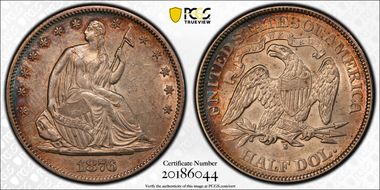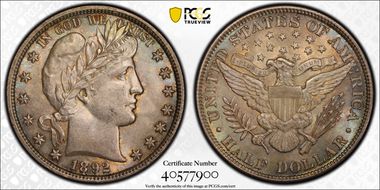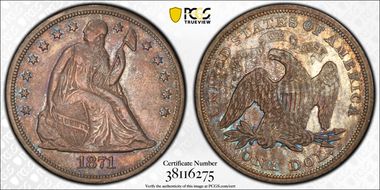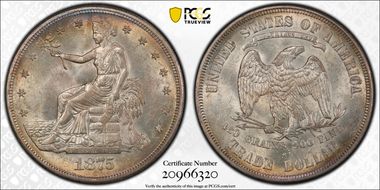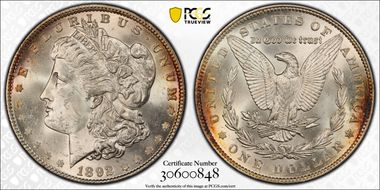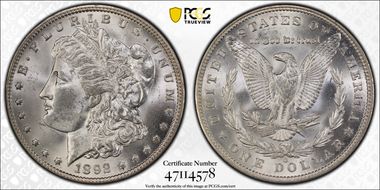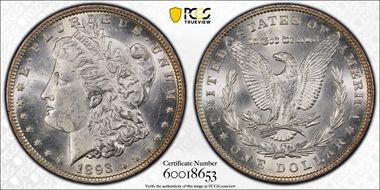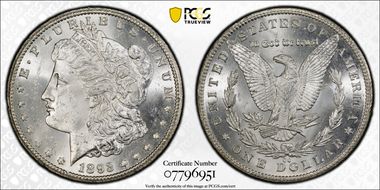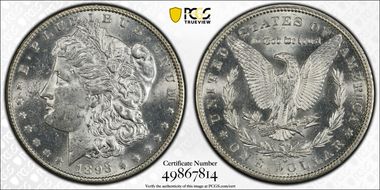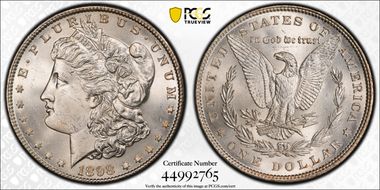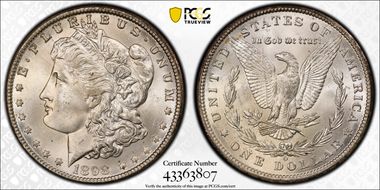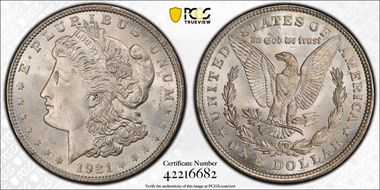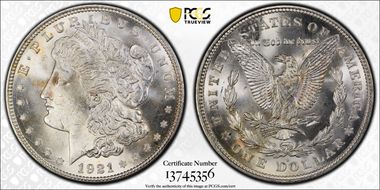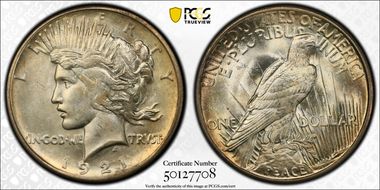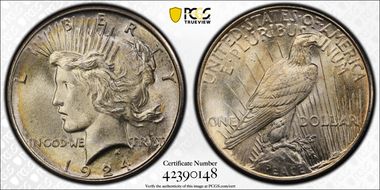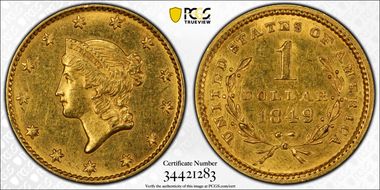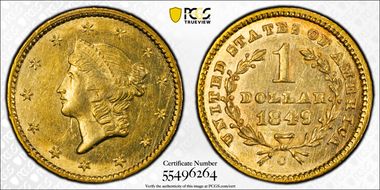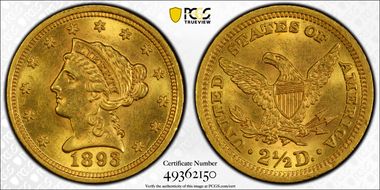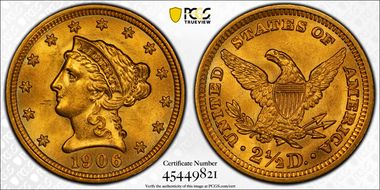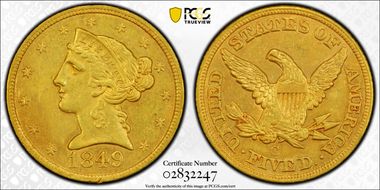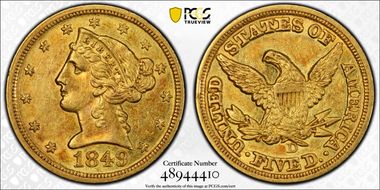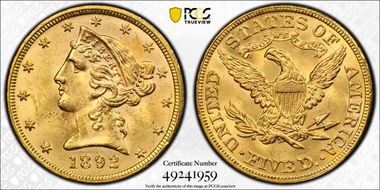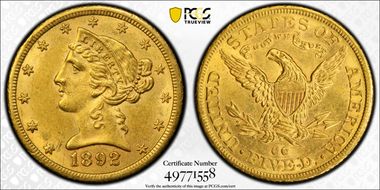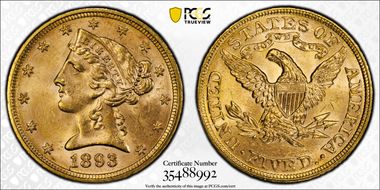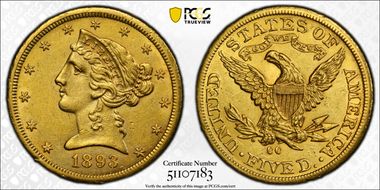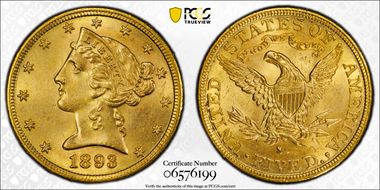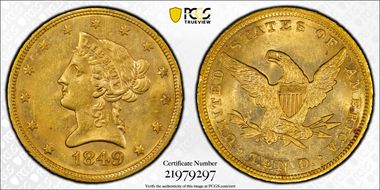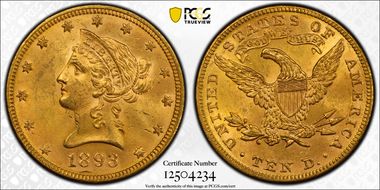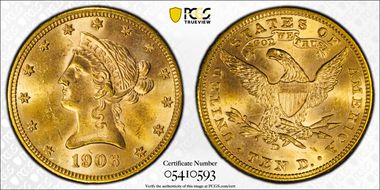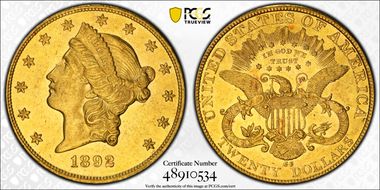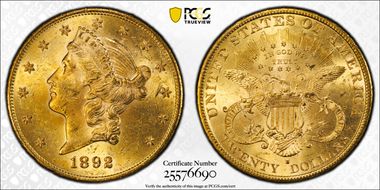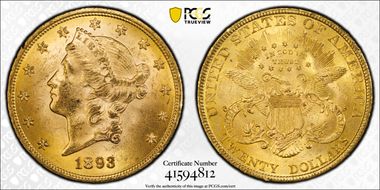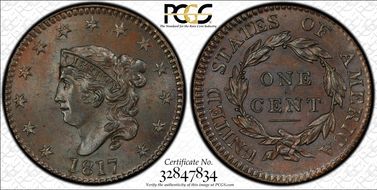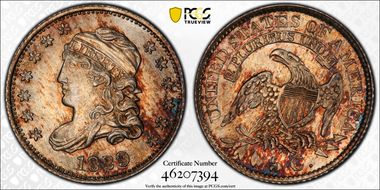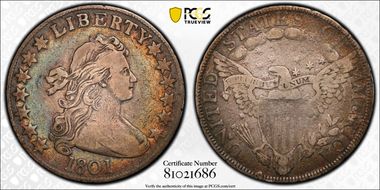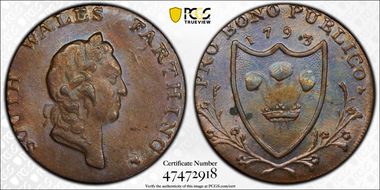audrop 的钱币相册
Hildebrand von Seinsheim IV (1301-1384): Born Stephasberg, Kleinlangheim, Kitzingen, Unterfranken, Bavaria, Germany; married Dorothea von Wenckheim (1305-?) in 1328; died Hasberger, Landskrels, Bavaria, (Bayern), Germany.
Jane Bradshaw Flinn (1825-1899): born 16 September Antigonish, Antigonish, Nova Scotia, Canada; married Michael Olding Patterson (1814-1861) 13 April 1842 Merigomish, Pictou, Nova Scotia, Canada; died 5 January Milton, Suffolk, Massachusetts, United States
Jane Hare (1808-1891): born 21 December England; married Hammond Reason Riggs (`1806-1879) 22 October 1828 Belmont, Ohio; died 20 October Batavia, Jefferson, Iowa.
Thomas Butler (1777-1852): born 23 October Bucks, Pennsylvania, British Colonial America; married Hannah Michener Balderson (1782-1833) 1801 Bucks, Pennsylvania, United States of America; died Short Creek, Harrison, Ohio, USA.
Emily Rowe (1803-1874): Born 1 August in Addison, Addison, Vermont; married Lionel Worth Knight (1797-1851) 1 January 1824 at New Haven, Addison, Vermont; died 27 February at New Milford, Winnebago, Illinois. Mary Eliza Bradshaw (1803-1869): Born in and died, 17 March in Antigonish, Nova Scotia, Canada.
Bonifacio de Saluzzo (1180-1212): Born Saluzzo, Cuneo, Piemonte, Italy; married Maria Lacon-Gunale di Torres (1181-1264) 24 August 1202; died 22 July Saluzzo, Cuneo, Piemonte, Italy.
Jane Hare (1808-1891): born 21 December England; married Hammond Reason Riggs (`1806-1879) 22 October 1828 Belmont, Ohio; died 20 October Batavia, Jefferson, Iowa.
Henry Holaday (1725-1800): born Chester, Pennsylvania, British Colonial America; married Mary Foyle (1723-1797) January 1746 Pennsylvania, British Colonial America; died 9 September Orange, North Carolina, USA.
Maria Carelszen Joosten (1660-1710): born 15 August New Amsterdam, New Netherland (17th century Dutch Colony in NA, (NY, NJ, De, Ct)); married Jacob's DeBevoise (1651-1710) 12 June 1678 NYC, NYC, NYC, BCA. Sarah Denison (1660?-1737): born Roxbury, Suffolk, Massachusetts Bay Colony, British Colonial America; married Tobijah Perkins (1646-1723) 5 November 1680 Topsfield, Essex, Massachusetts Bay Colony, BCA; died 5 December Topsfield, MBC, BCA. (John Guy (1660-????): born London, London, England; married Susannah Hall (1660-????) 14 February 1688. John Knight (1660-????); born Beverly, Essex, MBC, BCA; married Elizabeth Shapleigh ((1652-1736). James Lewis (1660-1726): born Anne Arundel, Maryland, BCA; married Katherine Randall (1660-1728) 1690 Anne Arundel, Maryland, BCA; died Anne Arundel, Maryland, BCA. Judith Maddiver (1660-1711): born Purpooduck, Cumberland, Maine, British Colonial America; married Samuel Lunt Ingersoll (1653-1732) 1679 Falmouth, Barnstable, Massachusetts Bay Colony, British Colonial America; died 1 May Gloucester, Essex, MBC, BCA. Mary Marvel (1660-1700); married William Stone (1638-1713) about 1685 Virginia,BCA; died Virginia, BCA. Evert Janssen Van Wickelen (1660-1722): born 17 June Wijckel, Friesland, Netherlands; married Metje Van Arsdalen (1670-1739) 27 February 1690 Flatbush, Kings, New York Colony, BCA; died before 2 February Flatbush, Ulster, New York Colony, BCA. Sarah Warren (1660-1761): born 25 January Roxbury, Suffolk,, MBC, BCA; married Stephen Garnett (1662-1715) 22 December 1687 Hingham, Suffolk, MBC, BCA; died 22 October Hingham, Suffolk, MBC, BCA. Unity White (1660-1695): born York, Virginia, BCA; married Ralph Graves, Jr. 1677 Yorktown, York, Virginia, BCA; died February, New Kent, Virginia, BCA. Samuel Woods Jr. (1660-1712): born 9 January Cambridge, Middlesex, MBC, BCA; married Hannah Farwell (1667-1739) 30 December 1685 Chelmsford, Middlesex, MBC, BCA: died 19 March Groton, Middlesex, MBC, BCA Richard Woolfolk II (1660-1741): born Yorkshire, England; married Elizabeth Hall (1665-1725) 1687 Gloucester, Gloucester, Virginia, BCA; died Abindon Parish, Gloucester, Virginia, BCA.
Elizabeth Birdsall (1784-1855): born 13 January Preston, Chenango, New York, USA; married Elisha Sanford Smith (1785-1866) 1807: died 13 May Alexander, Genesee, New York, USA.
Benjamen White, Sr. (1744-1808): born 5 October Little River MM, Perquimans, Carolina, British Colonial America.:
Rev James Shelburne (1738-1820): born 29 November Jamestown, James City, Colony of Virginia, British Colonial America; married Anne Pettus 22 September 1765 Lunenburg, Virginia, British Colonial America; died 6 March Lunenburg, Virginia, United States of America. William Charles (1738-1771): born 27 May Perquimans, North Carolina, British Colonial America; married Jane Albertson (1735-?) 10 April 1758 Perquimans, North Carolina, British Colonial America; died 5 January Wayne, North Carolina, British Colonial America.
Grace Tucker (17 July 1706-1746) Gloucester, Essex, Massachusetts Bay Colony. Steven Bennett (20 January 1706-after October 1754) Gloucester, Essex, Massachusetts Bay Colony. Elizabeth Heard (8 February 1706, Dover, Strafford, New Hampshire-at. 1765, Rochester, Strafford, New Hampshire). Married Robert Knight (1700-1768) in 1728 New Hampshire. Deborah Mack (11 October 1706-4 February 1776) Lyme, New London, Connecticut. Married Theophilus Lord (1698-1761) 8 May 1728. Margaret Farmer (2 September 1706, St. George's Parish, Baltimore, Maryland-before 30 August 1756, Baltimore, Maryland). Married Ford Barnes (1698-1749) on 17 September 1721 at St. Georges Parish.
Peter Probasco (1759-1803): born 25 November Somerset, Somerset, New Jersey, British Colonial America; married Mattye 8 September 1784 New Brunswick, Middlesex, New Jersey; died 20 July.
Sarah Hurd (1711=1770): born 24 August Harwich, Barnstable, Massachusetts Bay Colony, British Colonial America; married Seth Simon Covell (1705-1804) 22 November 1733 Harwich, Barnstable, Massachusetts Bay Colony, British Colonial America; died 22 November Harwich, Barnstable, Massachusetts Bay Colony, British Colonial America.
Thomasin Porter (1707-?): born Tunbridge Wells, Kent, England; married Malcolm Gillies (1703-?) 20 July 1724 Middlesex, England. Mehitable Kimball (1707-1777): born 9 November Wenham, Essex, Massachusetts Bay Colony, British Colonial America; died 15 February Ipswich, Essex, Massachusetts, USA. Eunice Willard (1707-1767): born Lancaster, Worcester, Massachusetts Bay Colony, British Colonial America; married Joseph Daby (1703-1767) 26 September 1724 Stow, Middlesex, Massachusetts Bay Colony, British Colonial America; died Lancaster, Worcester, Massachusetts, USA. Mary Wheeler (1707-1790): born 27 August Beverly, Massachusetts Bay Colony, British Colonial America; married Joseph Prentice (1704-1749) 10 November 1725 Griswold, New London, Connecticut Colony, British Colonial America; died 20 March Preston, New London, Connecticut, USA. Jane Langdon (1797-1795): born 2 April Nassau, Richmond, New York Colony, British Colonial America; married Nathan Birdsall, Sr. (1705-1784) 12 April 1726 Jamaica, Queens, New York Colony, British Colonial America; died Haviland, Hyde Park, Duchess, New York, USA.
Kings of all England. Cnut (Canute) (1016-35) Penny c.1017-23 Cambridge mint, Adam as moneyer, S-1157, North-781, MS63 PCGS. + CNVT REX ANGLOR, crowned bust left within quatrefoil / + AD| AM | ON G | RAT, voided long cross with crescent ends over quatrefoil with pellet at each apex. An appealing piece, slightly double-struck, with mauve toning. Hugh de LacyLord of Lassey (6 October 1008-27 March 1085)
John Guy (1660-????): born London, London, England; married Susannah Hall (1660-????) 14 February 1688. Judith Maddiver (1660-1711): born Purpooduck, Cumberland, Maine, British Colonial America; married Samuel Lunt Ingersoll (1653-1732) 1679 Falmouth, Barnstable, Massachusetts Bay Colony, British Colonial America; died 1 May Gloucester, Essex, MBC, BCA. Samuel Woods Jr. (1660-1712): born 9 January Cambridge, Middlesex, MBC, BCA; married Hannah Farwell (1667-1739) 30 December 1685 Chelmsford, Middlesex, MBC, BCA: died 19 March Groton, Middlesex, MBC, BCA. Maria Carelszen (1660-1710): born 15 August New Amsterdam, New Netherland (17th century Dutch Colony in NA, (NY, NJ, De, Ct)); married Jacob's DeBevoise (1651-1710) 12 June 1678 NYC, NYC, NYC, BCA.
Catherine Puffer (1750-????): born 26 June Stow, Middlesex, Massachusetts Bay Colony, British Colonial America. John Cochrane (1750-1823): born Lancaster, Lancaster, Pennsylvania, British Colonial America; married Margaret Francis Scott (1753-1840) 20 August 1723 Lincoln Kentucky, United States; died 5 July Whites, Madison, Kentucky. William Hines (1750-1830); married Elizabeth Harris (17853-1830); died Pennsylvania, United States. William Holliday, Sr. (1750-1812): born 10 June New Holland Township, Chester, Pennsylvania, British Colonial America; married Jane Andrew (1755-1831) 2 August 1777 Cane Creek MM, North Carolina, British Colonial America; died 28 August Orange, North Carolina, United States.
Margaret Miller: born Philadelphia, Pennsylvania; married Joseph Paxon Jr. (1800-1838) 24 May 1810 Philadelphia, Pennsylvania;
Patrick Flinn (1799-1875): born Ireland; married Mary Eliza Bradshaw (1803-1869) 28 February 1830 Antigonish, Nova Scotia, Canada; died 27 September Antigonish, Nova Scotia, Canada. William Lewis (1799-1870): born 13 January South Carolina, United States; married Anna Hollingsworth (1801-1853) 19 November 1818 Silver Creek MM, Union, Indiana, United States; died 10 August Illinois.
Lionel Worth Knight (1797-1851): born 14 October Strafford, Strafford, New Hampshire, USA; married Emily Rowe (1803-1974) 1 January 1824 New Haven, Addison, Vermont, USA; died 9 June Starksboro, Addison, Vermont, USA.
Hammond Reason Riggs (1806-1879): born 18 January Howard, Maryland, USA; married Jane Hare (1808-1891) 22 October 1828; died 7 December 1879 Batavia, Jefferson, Iowa, USA.
Lionel Worth Knight (1797-1851): born 14 October Strafford, Strafford, New Hampshire, USA; married Emily Rowe (1803-1974) 1 January 1824 New Haven, Addison, Vermont, USA; died 9 June Starksboro, Addison, Vermont, USA.
John Jay Pittman wasn’t a man of great financial resources but amassed one of the finest collections of United States and world coinage ever assembled. He worked as a chemical engineer for Eastman Kodak Company but spent much of his time as an ambassador for the hobby of numismatics. Between 1997 and 1999 his collection was sold at a series of three public auctions for prices totaling more than $30 million.
John Jay Pittman wasn’t a man of great financial resources but amassed one of the finest collections of United States and world coinage ever assembled. He worked as a chemical engineer for Eastman Kodak Company but spent much of his time as an ambassador for the hobby of numismatics. Between 1997 and 1999 his collection was sold at a series of three public auctions for prices totaling more than $30 million.
John Jay Pittman wasn’t a man of great financial resources but amassed one of the finest collections of United States and world coinage ever assembled. He worked as a chemical engineer for Eastman Kodak Company but spent much of his time as an ambassador for the hobby of numismatics. Between 1997 and 1999 his collection was sold at a series of three public auctions for prices totaling more than $30 million.
John Jay Pittman wasn’t a man of great financial resources but amassed one of the finest collections of United States and world coinage ever assembled. He worked as a chemical engineer for Eastman Kodak Company but spent much of his time as an ambassador for the hobby of numismatics. Between 1997 and 1999 his collection was sold at a series of three public auctions for prices totaling more than $30 million.
John H. Cochrane (1817-1859) L4SJ-BMK: born Madison, Missouri, United States; married Letitia Kelley (1817-1885) 28 October 1828 Putnam, Missouri, United States; died 10 July Cottage Grove, Lane, Oregon, United States. Letitia Kelley (1817-1885) LHTV-FVC: born 25 April Tennessee, United States; married John H. Cochrane (1817-1859) 28 October 1828 Putnam, Missouri, United States; died 30 December Cottage Grove, Lane, Oregon, United States.
Samuel Hymas (1816-1873) KHXS-QKS: born 7 July Philadelphia, Philadelphia, Pennsylvania,United States; married Anne Eliza Paxton (1821-1781) 25 May 1844 Philadelphia, Philadelphia, Pennsylvania, United States; died 24 October Philadelphia, Philadelphia, Pennsylvania, United States.
Rebecca M. White (1811-1849): Born 10 January; married Jonathan Hadley (1813-1848) 22 July 1834 Lick Creek MM, Orange, Indiana, USA; died 15 January 1849 Vermillion Grove, Vermillion, USA.
Samuel Hymas (1816-1873) KHXS-QKS: born 7 July Philadelphia, Philadelphia, Pennsylvania,United States; married Anne Eliza Paxton (1821-1781) 25 May 1844 Philadelphia, Philadelphia, Pennsylvania, United States; died 24 October Philadelphia, Philadelphia, Pennsylvania, United States.
Elizabeth Dishman (1804-1841): born Barren, Kentucky, USA; married Walker Pettus Redford (1805-1861) 5 November 1825 Glasgow, Barren, Kentucky, USA; died Barren, Kentucky, USA.
Priscilla Prentice (1729-1802): born 20 January Preston, New London, Connecticut Colony, British North America; married Peter Bundy (1720-1775) 14 July 1746 Preston, New London, Connecticut Colony, British North America; died 12 April 1802 Southampton, Hampshire, Massachusetts, United States of America. Martha Stone (1729-?) MKKY-N67 Hammutal Hammond (1729-?): born Maryland, British Colonial America. LBHF-X6K
Martha Patch (1763-1861): born 3 July Ipswich, Essex, Massachusetts Bay Colony, British Colonial America; married Cape. Oliver Appleton (1760-1852) 12 March 1789; died 30 September Hamilton, Essex, Massachusetts.
John Casshatt (1697-1748): born 21 May Bristol, Gloucestershire, England; married Mary Eleanor Broyles (1718-1788) 1739 Rocky River, Chatham, North Carolina, British Colonial America; died 16 November Waterford, Fairfax, Virginia. John Williams (1697-1728): born 1 June Isle of Wight, Virginia, British Colonial America; married Sarah Pierce (1702-1760) 22 February 1725 Perquimans, North Carolina, British Colonial America; died 23 December Perquimans, North Carolina. Joseph Wells, Sr. (1679-1758): born 30 September Queen Anne Parish, Prince George's, Maryland, British Colonial America; married Rachel Lindley (1698-1720) 1719 Prince George's, Maryland; died 27 May North Carolina. John Hammond (1679-1753): born 15 October St. Anne's Parish, Annapolis, Anne Arundel, Maryland, British Colonial America; married Sarah AnnDorsey (1698-1786) 1722 Baltimore, Maryland; died 23 October Gambrills, Anne Arundel, Maryland.
William Olding (1700-????): born 18 October Winchester, Hampton, England; married Marie Ann Purdue (1702-????) 14 November 1725 St. Lawrence, England. James Caller (1700?-1765?): born Westsester, Westchester, New York Colony, British Colonial America; married Maritime De Gree (1702-1765) 15 February 1722 Collegiate Church, New York City, British Colonial America; died Manor of Morrisania, Westchester, New York Colony, British Colonial America. Nathaniel Averill, Jr. (1700-1781): born 6 September Topsfield, Essex, Massachusetts bay Colony, British Colonial America; married Hannah Wildes (1709-1785) 24 November 1743 Topsfield, Essex, Massachusetts Bay Colony, British Colonial America; died 17 August Topsfield, Massachusetts, United States. Robert Knight (1700-1768): married Elizabeth Heard (1706-1765) 1728 New Hampshire, Amerique Coloniale Britainnique; died New Hampshire, Amerique Coloniale, Britainnique. Mary Cocke (1700-1754): born; married John Redford, Jr. 1723; and died Henrico, Virginia, British Colonial America. Thomas Salmon (1700-????): born Goochland, Goochland, Virginia, British Colonial America. Symon van Wicklen (1700-1755): born Flatbush, Kings, Colony of New York, British Colonial America; married Geraldina van Couvenhoven (1705-1754) 25 November 1722 Somerset, New York; died Somerset, Colony of New Jersey, British Colonial America. Mary Kuster (1700-1758): born 1 march Plumstead Township, Bucks, Pennsylvania, British Colonial America; married William Michener (1696-1780) 17 June 1720 Pennsylvania, British Colonial America; died 24 April.
Thomas Samson, Jr. (1710-1751): born 4 October; married Mary Adams (1714-1751) 11 August 1732; died 31 August all in Ipswich, Essex, Massachusetts Bay Colony, British Colonial America. Jonathan Brown (1710-?: born Lynn, Massachusetts Bay Colony, British Colonial America, married Hannah Davis (1713-1817) 3 December 1731 Ipswich, Essex, Massachusetts Bay Colony, British Colonial America. Mary Hooke (1710-1788): born 15 January; married Stephen Bennett (1706-1790) 2 January 1728 both in Salisbury, Essex, Massachusetts Bay Colony, British Colonial America; died 10 June Gloucester, Essex, Massachusetts, USA. William Stone III (1710-1777): born 5 October St. Peters Parish, New Kent, Virginia, British Colonial America; married Francis Taylor (1717-1792); 5 September Fluvanna County, Virginia, USA. Samuel Cochrane (1710-1772): born Lancaster, Pennsylvania, British Colonial America; married Sarah Woods (1712-1776) 1739 Ireland; died 9 October Rowan, North Carolina, British Colonial America. Ann Alan Simpson (1710-1790): born Scotland; married Mathew Hines (1713-1804) 1742 Whitemarsh Township, Montgomery, Pennsylvania, British Colonial America; died 1 December Warwick Township, Bucks, Pennsylvania, USA. Richard Holyfield Henderson (1710-1789): born Hanover County, Virginia, British Colonial America; married Elizabeth Branson (1732-1761); died 26 April Bush River, Edgefield County, South Carolina, USA. Richard Mitchell (1710-1748): born 26 August Harford, Maryland, British Colonial America; married Elizabeth Williams (1711-1774) 1 January 1733 St. George Parish, Baltimore, Maryland, British Colonial America; died 12 August Baltimore, Maryland, British Colonial America.
Gilbert Smith (1756-1795): born 7 January in Stonington, New London, Connecticut Colony, British Colonial America; married Delilah Bundy (1758-1846) on 3 January 1783 in Rochester, Monroe, New York, United States; died Salem. Washington, New York. Elizabeth Bolton (1756-1821): born Boltby, Yorkshire, England; married James Scurr (1745-1820) 16 January 1782 York, Yorkshire, England; died in May Boltby, Yorkshire, England.
Deborah Peavey (1698-1756): born Newington, Rockingham, New Hampshire, British Colonial America; married James Rawlins (1679-1743) 9 April 1717 Newington, Rockingham, New Hampshire, British Colonial America; died 23 November. Hannah Tuttle (1698-1776): born May Milford, New Haven, Connecticut Colony, British Colonial America; married John Rowe (1681-1757) 17 June 1736 New Haven, New Haven, Connecticut; died 12 November East Haven, New Haven, Connecticut. Theophius Lord (1698-1761): born 19 December Lyme, New London, Connecticut Colony, British Colonial America; married Deborah Mack 8 May 1728 Lyme, New London, Connecticut Colony, British Colonial America; died 28 February Hamburg, New London, Connecticut Colony, British Colonial America. Mary Jones (1698-1743): born 6 October New Haven, Connecticut, British Colonial America; married Samuel Elwell III (1696-1783) 12 October 1721; died New Haven, New Haven, Connecticut Colony, British Colonial America. Major John Salmon II (1698-1762) LCJ2-H28. Augustine Shelburne (1698-1764) MPW4-11Q. Edward Glew Scott (1698-1791) LZFC-RS9. Rachel Lindley (1698-1720)* L4SN-PJS.
Susanna Stevens (1717-1753): born 25 march Pembroke, Plymouth, Massachusetts Bay, British Colonial America; married David Pearce, Sr. (1713-1759) 20 January 1736 Gloucester, Essex, Massachusetts; died Gloucester. Comfort Haskell (1717-1809): born 22 May Gloucester, Essex, Massachusetts, British Colonial America; married Parker Sawyer (1719-1750) 10 November 1742; died 5 September. Lucy Fellows Stevens (1717-1806): 2 June Stonington, New London, Connecticut Colony, British Colonial America; married Ephraim Smith (1704-1774) 3 January 1744 Stonington; died 4 May Montgomery, Pennsylvania, United States. Francis Taylor (1717-1792): born 26 January St. Peer's Parish, New Kent County, Province of Virginia, British Colonial America; married William Stone III (1710-1777); died 5 June Fluvanna County, Virginia, United States. Amy Anne Walker (1717-1778): born 25 February New Kent, Virginia, British Colonial America; married Colonel Thomas Pettus (1712-1780) 10 November 1735 Hanover, Virginia; died 22 October Cumberland Parish, Lunenburg, Virginia. John Edmundson (1717-1780): born Craven North Carolina, British Colonial America; married Mary Cullen (1825-1822); died Dobbs, North Carolina, United States. Hannah McKay (1717-1754): born 1 July Augusta Parish, Augusta, Virginia, British Colonial America; married George Hollingsworth (1712-1786) 19 December 1734 Chester, Pennsylvania; died 9 March Winchester, Frederick, Virginia,
Elizabeth One (1649-?): Born Carisbrooke, Isle of Wight, Hampshire, England. Ex. S. Birchall of Leeds Graded MS63 by NGC #5953815-001
Abraham Hollingsworth (1686-1748): born 18 January Rockland, New Castle, Delaware, British Colonial America; married Ann Robinson (1690-1749) 13 march 1709 Frederick, Virginia, British Colonial America; died 1 October Winchester, Frederick, Virginia, British Colonial America. Richard heaven Sr. (1686-1738): born 7 January Calvert, Maryland, British Colonial America; married Mary Jane Blanford 1705 Prince George's, Maryland, British Colonial America; died 28 February Prince George's, Maryland, British Colonial America. Anna Maria Van Leeuwan (1686-1752): born 26 April Jamaica, Queens, New York Colony, British Colonial America; married Jakob Probasco (1682-1755); died 22 December Somerset, Somerset, New Jersey, British Colonial America. Elsje Janse Staats (1686-1762): born 7 February Gowanus, Kings, New York Colony, British Colonial America; married Nicasius Jansen van Kouwenhoven (1681-1749) 3 November 1703 Brooklyn, Kings, New York Colony, British Colonial America; died Brooklyn, Kings, New York Colony, British Colonial America.
Edward Rawlins (1718-1756): born 2 March Newington, Rockingham, New Hampshire, British Colonial America; married Elizabeth Knight Nutter 21 November 1742 Newington; died 25 May Dover, Straford, New Hampshire. Peter Dishman (1718-1772): born Westmoreland, Virginia, British Colonial America; married Sarah Reynolds (1723-1808) 1745 Virginia; died Tappahannock, Essex, Virginia. Mary Eleanor Broyles (1718-1788): born Virginia, British Colonial America; married John Cassatt (1697-1748) 1739 Rocky River, Chatham North Carolina; died North carolina, United States.
Mary Ann Steavenson (1643-1719): born and died Raphoe, Donegal, Ireland. William Ellery, Jr (1643-1696): born Bristol, England; married Mary Coit (1655-1730) 13 June 1676 Lewiston, Androscoggin, Maine, British Colonial America; died 9 December Gloucester, Essex, Massachusetts Bay Colony, BCA. John Hogg (1643-1728): born 4 March Boston, Suffolk, MBC, BCA; married Ebenezer Emery (1648-1694) 21 April 1669 Newbury, Essex, MBC, BCA; died 21 April Newbury, Essex, MBC, BCA. Andrew Sanford, Jr. (1643-1705): born 11 November Hartford, Hartford, Colony of Connecticut, BCA; married Mary Botsford (!643-1687) 8 January 1667 Milford, New Haven, CoC, BCA; died August Milford, New Haven, CoC, BCA. Mary Botsford (1643-1687): born 21 May Milford, New Haven, CoC, BCA; married (see above); died January Hartford, CoC, BCA. Sarah Woodward (1643-1706): born 3 February Watertown, MBC, BCA; married Steven Gates (1640-1707) about 1664 Middlesex, MBC, BCA; died 21 October Stow, Middlesex, MBC, BCA. Hannah Denison (1643-1715): born 20 May Roxbury, MBC, BCA; married Nathanial Chesebrough March 1659; died 18 October Stonington, New London, CoC, BCA. Mercy Williams (1643-1739): born Eastham, Barnstable, MBC, BCA; married William Nickerson, Jr. 30 November 1668 Chatham, Barnstable, MBC, BCA; died 7 April Chatham, Barnstable, MBC, BCA. Mary Ann Hussey (1643-1714): born Charles, Maryland, BCA; married John Hanson (1630-1713) Charles, Maryland, BCA; died 7 May Port Tobacco, Charles, Maryland, BCA. Jeremiah Ellis, Sr. (1643-1723): born James City, Virginia, BCA; married Mary (1648-1722) VA, BCA; died Surry, VA, BCA.
William Olding (1700-????): born 18 October Winchester, Hampton, England; married Marie Ann Purdue (1702-????) 14 November 1725 St. Lawrence, England. James Caller (1700?-1765?): born Westsester, Westchester, New York Colony, British Colonial America; married Maritime De Gree (1702-1765) 15 February 1722 Collegiate Church, New York City, British Colonial America; died Manor of Morrisania, Westchester, New York Colony, British Colonial America. Nathaniel Averill, Jr. (1700-1781): born 6 September Topsfield, Essex, Massachusetts bay Colony, British Colonial America; married Hannah Wildes (1709-1785) 24 November 1743 Topsfield, Essex, Massachusetts Bay Colony, British Colonial America; died 17 August Topsfield, Massachusetts, United States. Robert Knight (1700-1768): married Elizabeth Heard (1706-1765) 1728 New Hampshire, Amerique Coloniale Britainnique; died New Hampshire, Amerique Coloniale, Britainnique. Mary Cocke (1700-1754): born; married John Redford, Jr. 1723; and died Henrico, Virginia, British Colonial America. Thomas Salmon (1700-????): born Goochland, Goochland, Virginia, British Colonial America. Symon van Wicklen (1700-1755): born Flatbush, Kings, Colony of New York, British Colonial America; married Geraldina van Couvenhoven (1705-1754) 25 November 1722 Somerset, New York; died Somerset, Colony of New Jersey, British Colonial America. Mary Kuster (1700-1758): born 1 march Plumstead Township, Bucks, Pennsylvania, British Colonial America; married William Michener (1696-1780) 17 June 1720 Pennsylvania, British Colonial America; died 24 April.
Samuel Symonds (1793-1852): born 17 October Hillsborough, Hillsborough, New Hampshire; married Mary Eliza Bradshaw (!803-1869); died July. Pearcy Edmundson (1793-1854): born 4 March Wayne, North Carolina; married William E. Morris (1791-1850) 1812 Vermillion, Indiana; died 11 October Coloma, Park, Indiana.
Margaret Miller: born Philadelphia, Pennsylvania; married Joseph Paxon Jr. (1800-1838) 24 May 1810 Philadelphia, Pennsylvania;
Margaret Miller: born Philadelphia, Pennsylvania; married Joseph Paxon Jr. (1800-1838) 24 May 1810 Philadelphia, Pennsylvania;
Margaret Miller (1795-?): Philadelphia, Philadelphia, Pennsylvania, United States; married Joseph Paxon, Jr. 24 May 1810 Philadelphia, Philadelphia, Pennsylvania, USA.
Margaret Miller: born Philadelphia, Pennsylvania; married Joseph Paxon Jr. (1800-1838) 24 May 1810 Philadelphia, Pennsylvania;
Kelley (1792-?): born Tennessee.
Margaret Miller: born Philadelphia, Pennsylvania; married Joseph Paxon Jr. (1800-1838) 24 May 1810 Philadelphia, Pennsylvania;
Captain-Blacksmith, George Appleton (1796-1862); born 29 July Ipswich, Essex, Massachusetts; married Martha Patch (1763-1861) 12 March 1789 Ipswich, Essex, Massachusetts; died 21 November Hamilton, Essex, Massachusetts. Letitia: born 1796(?) Virginia.
Captain-Blacksmith, George Appleton (1796-1862); born 29 July Ipswich, Essex. Massachusetts; married Mehitable Lovering (1801-1862) 29 May 1821 Hamilton, Essex, Massachusetts; died 21 November Hamilton, Essex, Massachusetts. Letitia: born in Virginia.
Mehitable Lovering (1801-1862): born 14 May Hamilton, Essex, Massachusetts, USA; married Captain-Blacksmith, George Appleton (1796-1862) 29 May 1821 Hamilton, Essex, Massachusetts, USA; died 4 February Hamilton, Essex, Massachusetts, USA. Anna Hollingsworth (1801-1853): born 15 November South Carolina, USA; married William Lewis (1799-1870) 19 November 1818 Silver Creek MM, Union, Indiana, USA; died Illinois, USA.
Deborah Peavey (1698-1756): born Newington, Rockingham, New Hampshire, British Colonial America; married James Rawlins (1679-1743) 9 April 1717 Newington, Rockingham, New Hampshire, British Colonial America; died 23 November. Hannah Tuttle (1698-1776): born May Milford, New Haven, Connecticut Colony, British Colonial America; married John Rowe (1681-1757) 17 June 1736 New Haven, New Haven, Connecticut; died 12 November East Haven, New Haven, Connecticut. Theophius Lord (1698-1761): born 19 December Lyme, New London, Connecticut Colony, British Colonial America; married Deborah Mack 8 May 1728 Lyme, New London, Connecticut Colony, British Colonial America; died 28 February Hamburg, New London, Connecticut Colony, British Colonial America. Mary Jones (1698-1743): born 6 October New Haven, Connecticut, British Colonial America; married Samuel Elwell III (1696-1783) 12 October 1721; died New Haven, New Haven, Connecticut Colony, British Colonial America. Major John Salmon II (1698-1762) LCJ2-H28. Augustine Shelburne (1698-1764) MPW4-11Q. Edward Glew Scott (1698-1791) LZFC-RS9. Rachel Lindley (1698-1720)* L4SN-PJS.
John Lovering III (1746-1832): born Topsfield, Essex, Massachusetts, British Colonial America; married Hannah Averill 23 January 1773 Ipswich, Essex, Massachusetts, British Colonial America; died Hamilton, Essex, Massachusetts, United States. Job Knights (1746-1786): born 10 September Gloucester, Essex, Massachusetts, British Colonial America; married Abigail Bennett (1747-1803) 12 August 1767; died lost at sea.
William Samuel Dishman (1754-1833): born 26 September Essex, Virginia, British Colonial America; married Sarah Salmon (1764-1839) 2 February 1784 Bedford, Virginia, United States; died 4 December Barren, Kentucky, United States.
John Guy (1660-????): born London, London, England; married Susannah Hall (1660-????) 14 February 1688. Judith Maddiver (1660-1711): born Purpooduck, Cumberland, Maine, British Colonial America; married Samuel Lunt Ingersoll (1653-1732) 1679 Falmouth, Barnstable, Massachusetts Bay Colony, British Colonial America; died 1 May Gloucester, Essex, MBC, BCA. Samuel Woods Jr. (1660-1712): born 9 January Cambridge, Middlesex, MBC, BCA; married Hannah Farwell (1667-1739) 30 December 1685 Chelmsford, Middlesex, MBC, BCA: died 19 March Groton, Middlesex, MBC, BCA. Maria Carelszen (1660-1710): born 15 August New Amsterdam, New Netherland (17th century Dutch Colony in NA, (NY, NJ, De, Ct)); married Jacob's DeBevoise (1651-1710) 12 June 1678 NYC, NYC, NYC, BCA.
Truman Bevins (1752-????): born Howard County, Maryland, British Colonial America; married Margaret McFall (1753-1780) in 1774 Baltimore, Maryland, British Colonial America.
Virginia Anne Pettus (1749-1831): born 31 January Lunenburg, Virginia, British Colonial America; married Rev James Shelburne (1738-1820) 22 September 1765 Lunenburg, Virginia, British Colonial America; died 9 March Lunenburg, Virginia, British Colonial America.
Patrick Flinn (1799-1875): born Ireland; married Mary Eliza Bradshaw (1803-1869) 28 February 1830 Antigonish, Nova Scotia, Canada; died 27 September Antigonish, Nova Scotia, Canada. William Lewis (1799-1870): born 13 January South Carolina, United States; married Anna Hollingsworth (1801-1853) 19 November 1818 Silver Creek MM, Union, Indiana, United States; died 10 August Illinois.
Martha Patch (1763-1861): born 3 July Ipswich, Essex, Massachusetts Bay Colony, British Colonial America; married Cape. Oliver Appleton (1760-1852) 12 March 1789; died 30 September Hamilton, Essex, Massachusetts.
Caleb White (1740-1795): born 8 March Perquimans MM, Perquimans, North Carolina, British Colonial America; married Rachel Jordan (1703-1768) 4 February 1761 Perquimans, North Carolina, British Colonial America; died 26 February Perquimans, North Carolina, United States of America.
Martha Patch (1763-1861): born 3 July Ipswich, Essex, Massachusetts Bay Colony, British Colonial America; married Cape. Oliver Appleton (1760-1852) 12 March 1789; died 30 September Hamilton, Essex, Massachusetts.
Sitie Probasco (1787-1868) MW1P-4NV: born 2 August New Brunswick, Middlesex, New Jersey; married William Woolley (1768-????).
John Parsons (1693-?) MFG5-K12 John Goss (1693-1746) LBM7-R7Q Sarah 'Sally' Spencer (1693-1743) LZ8F-W6V Susanna (1693-?) KN4P-CYJ John Boulton (1693-?) MJ1Q-2TW
Thomasin Porter (1707-?): born Tunbridge Wells, Kent, England; married Malcolm Gillies (1703-?) 20 July 1724 Middlesex, England. Mehitable Kimball (1707-1777): born 9 November Wenham, Essex, Massachusetts Bay Colony, British Colonial America; died 15 February Ipswich, Essex, Massachusetts, USA. Eunice Willard (1707-1767): born Lancaster, Worcester, Massachusetts Bay Colony, British Colonial America; married Joseph Daby (1703-1767) 26 September 1724 Stow, Middlesex, Massachusetts Bay Colony, British Colonial America; died Lancaster, Worcester, Massachusetts, USA. Mary Wheeler (1707-1790): born 27 August Beverly, Massachusetts Bay Colony, British Colonial America; married Joseph Prentice (1704-1749) 10 November 1725 Griswold, New London, Connecticut Colony, British Colonial America; died 20 March Preston, New London, Connecticut, USA. Jane Langdon (1797-1795): born 2 April Nassau, Richmond, New York Colony, British Colonial America; married Nathan Birdsall, Sr. (1705-1784) 12 April 1726 Jamaica, Queens, New York Colony, British Colonial America; died Haviland, Hyde Park, Duchess, New York, USA.
1076996 | GREAT BRITAIN. England. William III. (King, 1694-1702). 1698 AR Halfcrown. PCGS MS63. By Roettier. Tower mint (London). Edge: DECUS ET TUTAMEN ANNO REGNI DECIMO. GVLIELMVS· III·DEI·GRA . First laureate and draped bust, right; legend around / MAG BR·FRA ET·HIB REX·16 98·. Crowned cruciform shields around central Nassau lion, divided date above; legend around. KM 492.2; SCBC-3494; ESC 554.
Delilah Bundy (1758-1846); born 7 September Preston, New London, Connecticut, British Colonial America; married Stephen Andrus (1754-?) 1779 Preston, New London, Connecticut, United States, Gilbert Smith (1756-1795) 3 January 1783 Rochester, Monroe, New York, USA; died 24 March Le Roy, Genesee, New York, USA.
Sitie Probasco (1787-1868) MW1P-4NV: born 2 August New Brunswick, Middlesex, New Jersey; married William Woolley (1768-????).
Mary Johnson (1689-1766): Born Westerly, Kings, Rhode Island, British Colonial America; married James Bundy, Jr. (1688-1762) 1710 Preston, New London, Connecticut Colony, British Colonial America; died after 4 May Preston, New London, Connecticut Colony, British Colonial America. William DePriest (1689-1737): Born October St. Peters Parish, New Kent, Virginia Colony, British Colonial America; married Judith (1708-1796) 1725 Goochland, Virginia Colony, British Colonial America; died 2 March Goochland, Virginia Colony, British Colonial America. Mary Royale (1689-1749): Born 24 October Scotland, Chester, Pennsylvania, British Colonial America; married Jeremiah Brown (1687-1767) 1710; died 31 July Rising Sun, Cecil, Maryland, British Colonial America. Mary Wheeler (1689-1761): Born Baltimore, Maryland, British Colonial America; married Major Thomas Williams (1685-1733) 6 December 1706 Baltimore, Maryland, British Colonial America; died Baltimore, Maryland, British Colonial America.
Thomas Butler (1777-1852): born 23 October Bucks, Pennsylvania, British Colonial America; married Hannah Michener Balderson (1782-1833) 1801 Bucks, Pennsylvania, United States of America; died Short Creek, Harrison, Ohio, United States of America.
Lionel Worth Knight (1797-1851): born 14 October Stratford, Stratford, New Hampshire; married Emily Rowe (1803-1874) 1 January 1824 New Haven, Addison, Vermont; died 9 June Starksboro, Addison, Vermont.
Captain-Blacksmith, George Appleton (1896-1862); born 29 July Ipswich, Essex. Massachusetts; married Mehitable Lovering (1801-1862) 29 May 1821 Hamilton, Essex, Massachusetts; died 21 November Hamilton, Essex, Massachusetts. Letitia: born in Virginia.
Samuel Symonds (1793-1852): born 17 October Hillsborough, Hillsborough, New Hampshire; married Mary Eliza Bradshaw (!803-1869); died July. Pearcy Edmundson (1793-1854): born 4 March Wayne, North Carolina; married William E. Morris (1791-1850) 1812 Vermillion, Indiana; died 11 October Coloma, Park, Indiana.
Abraham Hollingsworth (1686-1748): born 18 January Rockland, New Castle, Delaware, British Colonial America; married Ann Robinson (1690-1749) 13 march 1709 Frederick, Virginia, British Colonial America; died 1 October Winchester, Frederick, Virginia, British Colonial America. Richard heaven Sr. (1686-1738): born 7 January Calvert, Maryland, British Colonial America; married Mary Jane Blanford 1705 Prince George's, Maryland, British Colonial America; died 28 February Prince George's, Maryland, British Colonial America. Anna Maria Van Leeuwan (1686-1752): born 26 April Jamaica, Queens, New York Colony, British Colonial America; married Jakob Probasco (1682-1755); died 22 December Somerset, Somerset, New Jersey, British Colonial America. Elsje Janse Staats (1686-1762): born 7 February Gowanus, Kings, New York Colony, British Colonial America; married Nicasius Jansen van Kouwenhoven (1681-1749) 3 November 1703 Brooklyn, Kings, New York Colony, British Colonial America; died Brooklyn, Kings, New York Colony, British Colonial America.
Abraham Hollingsworth (1686-1748): born 18 January Rockland, New Castle, Delaware, British Colonial America; married Ann Robinson (1690-1749) 13 march 1709 Frederick, Virginia, British Colonial America; died 1 October Winchester, Frederick, Virginia, British Colonial America. Richard heaven Sr. (1686-1738): born 7 January Calvert, Maryland, British Colonial America; married Mary Jane Blanford 1705 Prince George's, Maryland, British Colonial America; died 28 February Prince George's, Maryland, British Colonial America. Anna Maria Van Leeuwan (1686-1752): born 26 April Jamaica, Queens, New York Colony, British Colonial America; married Jakob Probasco (1682-1755); died 22 December Somerset, Somerset, New Jersey, British Colonial America. Elsje Janse Staats (1686-1762): born 7 February Gowanus, Kings, New York Colony, British Colonial America; married Nicasius Jansen van Kouwenhoven (1681-1749) 3 November 1703 Brooklyn, Kings, New York Colony, British Colonial America; died Brooklyn, Kings, New York Colony, British Colonial America.
Joseph Safford ,Sr. (1631-1701): Born 29 August Ipswich, Essex, Massachusetts Bay Colony, British Colonial America; married Mary Baker (1637-1683) 4 March 1660 Ipswich, Essex, Massachusetts Bay Colony, British Colonial America; died 29 August Ipswich, Essex, MBC, BCA. Abigail Clark (1632-1710): Born Gloucester, Essex, Massachusetts Bay Colony, British Colonial America; married William Sargent (1624-1716) 10 September 1651 Ipswich, Essex, MBC, BCA; died 8 March Gloucester, Essex, MBC, BCA. Sarah Shattuck (1631-1724): Born 4 April Salem, Essex, MBC, BCA; married Richard Gardner (1621-1688) abt. 1652 Salem, Essex, MBC, BCA; died 4 April Nantucket, Nantucket, MBC, BCA. John Tuttle (1631-1683): Born 8 December Ringstead, Northamptonshire, England; married Katherine Lane (1631-1669) 8 November 1653 Newhaven Towne, New Haven, Connecticut; died 12 November New Haven, New Haven, Connecticut, BCA. Sarah Felton (1631-1679): Born Stow, Middlesex, BCA; married John Darby (1633-1669) 1655 Concord Township, Somerset, MBC, BCA; died Massachusetts, BCA. Hannah Eaton (1632-1707): Born 17 October London, Middlesex, England; married William Jones (1623-1706) July 1659 London, Middlesex, England; died 4 May New Haven, New Haven, Connecticut Colony, BCA. Ann Lawrence (1632-1695): Born England; married Francis Redford (1615-1693) October 1656 Charles City County, Virginia, BCA; died 2 September Henrico, Virginia, BCA. Margaret Smyth (1631-1681): Born 30 January Falkirk, Stirlingshire, Scotland; married Sir John Buchanan 1st Laird of Blairlusk (1620-1682) 1657 Scotland; died Buchanan, Stirlingshire. Scotland. Mary Parker (1632-1699): Born London, England; married John Hall (1628-1660) 1653 Maryland, BCA; died 24 December Anne Arundel, Maryland, BCA. Dirck Janse Woertman (1631-1694): Born 7 December Amsterdam, North Holland, Netherlands; married Marritje Teunis Nyssen 7 March 1660 Brooklyn, Kings, New York Colony, BCA; died 10 April Brooklyn, Kings, NYC, BCA. James Brathwaite (1632-1665): Born 6 June Hawkshead, Lancashire, England; married Margaret (1630-1691); died Cumbria, England. Henry White (1631-1671): Born York, Virginia, BCA; married Mary Croshaw (1631-1679) 1653 York, Virginia, BCA; died 6 January York, Virginia, BCA. Mary Croshaw (1631-1679): Born Jamestown, James City, Virginia, BCA; married (see above); died 3 March Pasquotank, Pasquotank, North Carolina, BCA. Elizabeth Prieste (1631-1668): Born 1 January Kingston, Surrey, England; married Henry Wilcock (1634-1684) 13 November 1638 St. Mary Aldermary; died Colony of Maryland, BCA. Valentine Hollingsworth (1632-1710): Born 6 August Ballyvickcrannell, Seagoe, County Armagh, Northern Ireland, United Kingdom; married Ann Lee (1628-1671) 7 June 1655 Lurgan, County Armagh, Northern Ireland, United Kingdom; died 13 October Newark, New Castle, Delaware, BCA.
William Callore (Callar), born in New York around 1679; married Susan Chetty (1681) in Westchester County, New York and died in Westchester, New York. Sarah Fitch: born 1679, married Zechariah Whitman Jr. 6 Jan 1702, both in Milford, Connecticut; and died 27 Nov 1705 at Norwalk, CT. Mary Mansfield: born 1679 in Jamestown, Virginia, married Augustine Shelborne in 1896 at Henrico, Virginia. Margaret Stephenson: born 1679 in County Londonderry, Ireland; married Andrew Cochrane (1675-) abt. 1721 at Carikeel, Londonderry, Ulster, Ireland. Jeanne Hermant: born 1679; married Andre Cochet (1675-1728); died 1737. Johannes Broyles: born 1 May 1879 at Kumbach, Landkreis Karlsruhe, Baden-Wurttemberg, Germany; married Ursula Ruop (1680-1733) 6 November 1703 at Otishelm, Germany. Robert Mackay Sr.: Born 1679 at Dornoch, Sutherland, Scotland; married Anne Browne (1687-1726); died 19 August 1752. Charles II: Born at St. James Palace on 29th May 1630. He spent a long exile in France and returned after the fall of the Protectorate in 1660. The Restoration commenced and he married Catherine of Braganza, but he bore no legitimate successor. Charles II died on 6th February 1685.
William E. Morris (1791-1850): born 24 May in Wayne, North Carolina, British Colonial America; married Pearcy Edmundson (1793-1854) in 1812 Vermillion, Indiana; died 7 April at Rocky Run, Parke, Indiana.
William Olding (1635-1723): born Kent, England; married Anne Kervill (1646-?) 15 October 1665 Eling, Hampshire, England, United Kingdom.
William Haynes (1640-1702): Born Chedworth, Gloucestershire, England; married Margery White (1640-deceased) abt. 1663 Lewiston, Androscoggin, Maine; died Newbury, Essex, Massachusetts Bay Colony, British Colonial America. William Worth (1640-1724): Born Plymouth, Devon, England; married Sarah Macy (1646-1701) 11 April 1665 Nantucket, Nantucket, Massachusetts Bay Colony, British Colonial America and later Damaris Sibley (1666-1745); died 11 November in Nantucket. Thomas Howell (1640-?): Born England, married Mary English (1655-1732). Robert Cartwright (1641-1676): Born Droitwich, Worcestershire, England; married Elizabeth Orchard (1643-1676) in 1664 Surry, Surry, Virginia; died Southwark Parish, James City, Virginia, British Colonial America.
Rebecca M. White (1811-1849): born 10 January; married Jonathan Hadley (1813-1848) 22 July 1834 Lick Creek MM, Orange, Indiana; died 15 January Vermillion Grove, Vermillion, Illinois.
Petronella Bettesley (1248-?); married Sir Thomas Crane (1255-?) 1273 Suffolk, England. Sofie Christine Nilsdotter Tokesen (1250-1293); married Peder Lauridsen Saltensee (1255-1333); died Tystofte, Tjaereby, Vester Flakkebjerg, Soro, Denberg. Esge Olufsen Blis (1250-1290). John Grounde (1250-?); born Amersham, Raans, Buckingham, England. Margery Elleforde (1250-1290); married Peter Arderne (1241-1292) 1271 Aldford, Cheshire, England. William Madog (1250-?)
GilleBride MacGille Adomnan (1080-1164): Born Morven, Argyll, Scotland; married Agatha Gormflarth Haakensdottir (1090-?) Orkney Islands, Orkney, Scotland; died Renfrew, Renfrewshire, Scotland. Olafr Guoredarson, King of Man (1080-1153): Born Isle of Man; married Ingeborg Ingibjorg Haakensdottir (?-1152) before 1135 Isle of Man; died 29 June Ramsey, Isle of Man, Argyll, Scotland. More to add.
William Woolley (1768-?): born England; married Sitie Probasco (1787-1868) 1804.
Patrick Flinn (1799-1875): born Ireland; married Mary Eliza Bradshaw (1803-1869) 28 February 1830 Antigonish, Nova Scotia, Canada; died 27 September Antigonish, Antigonish, Nova Scotia, Canada.
Margaret Miller: born Philadelphia, Pennsylvania; married Joseph Paxon Jr. (1800-1838) 24 May 1810 Philadelphia, Pennsylvania;
Thomas Mitchell: Born 19 January 1639 and died 1699 both at Ballinturley, Castle Strong, Roscommon, Ireland. Joan Smoote: Born 1625 in Ireland. Simon Hadley: Born 1640 West Meath, Kings County, Ireland. Died 6 June 1711 County Westmeath, Ireland. William Gregg, Jr.: Born 1642 Ardmore, Waterford, Ireland. Died 1 July 1687 New Castle, Colony of Delaware, British Colonial America. Martha Ann Wilkinson: Born 1644 Ardmore, Waterford, Ireland. Died 5 January 1692 Strand Milles, New Castle, Colony of Delaware, British Colonial America. Valentine Hollingsworth, Sr.: Born June 1632 Belleniskcrannel, Parish of Legoe, Aramagh County, Ireland. Buried in Friends Cemetery, Newark, New Castle, Delaware. Anne Ree: Belleniskcrannel, Segoe Parish, Armagh, Ireland. Died 1 April 1671 Moyraverty, Armagh, Ireland. George Robinson: Born 1636 Belleniskcrannel, Armagh, Ireland. Died 14 February 1694 New Castle, Delaware.
Margaret Charles (1768-1854): Born 22 July Piney Woods, Perquimans, North Carolina, USA; married Jeremiah Morris (1766-1826) 22 February 1789 Contentnea, Pitt, North Carolina, USA; died 12 October Coloma, Parke, Indiana, USA. Rachael Cook (1768-1851): Born 29 February Bush River Mm, Newberry, South Carolina, USA; married Thomas Lewis (1768-1815) 28 February 1793 South Carolina, USA; died 30 June Waynesville, Warren, Ohio, USA. Sarah Goldsmith (1768-1854): Born 2 April Salem, Essex, Massachusetts, USA; married Joseph Lovering (1764-1824) 11 December 1794 Andover, Essex, Massachusetts, USA; died 18 June Hamilton, Massachusetts, USA. Edward Knight (1768-1824): Born 24 January Rochester, Strafford, New Hampshire, USA; married Elizabeth Worth (1775-1824) 17 February 1795 Loudon, Merrimack, New Hampshire, USA; died 20 August Starksboro, Addison, Vermont, USA. Thomas Lewis (1768-1815): Born South Carolina, USA; married (see Rachael Cook); died 25 April Wayne, Indiana, USA. William Woolley (1768-????): Born January England; married Sitie Probasco 1804.
Martha Mitchell (1739-1832): born 21 July; married Lionel Worth (1737-1805) Massachusetts Bay, Colonial British America; died 18 April 1832 Starksboro, Addison, Vermont, United States. Mary Cashet (1739-1794): born Cane Creek, MM (Friend's Monthly Meeting), Orange, North Carolina, British Colonial America; married Capt. Joseph Hadley (1745-1793); died 19 November 1794 at Snow Camp, Alamance, North Carolina, United States. Elizabeth Mitchell (1739-1832): born 10 June St. George's Parish, Baltimore, Maryland, British Colonial America; married Gregory Farmer Barnes, Sr. (1734-1808) 30 November 1758 St. George's Parish, Baltimore, Maryland; died 18 April Hartford, Maryland, United States.
Anne Eliza Paxton (1821-1891): born 22 September Philadelphia, Philadelphia, Pennsylvania, USA; married Samuel Hymas (1816-1873) 25 May 1844 Philadelphia Monthly Meeting; died 28 August Philadelphia, Philadelphia, Pennsylvania, USA. Mary Ann Lewis (1821-1851): born 15 March Bloomingdale, Park, Indiana, USA; married Jeremiah Morris (1815-1887) 1837 Vermillion Grove, Vermillion, Illinois, USA; died 25 May Pilot Grove, Hancock, Illinois, USA.
Dorcas Sawyer (1769-1825): born 13 August Gloucester, Essex, Massachusetts Bay Colony, British Colonial America; married Jonathon Brown (1742-1809) 17 December 1789; died 29 September Gloucester, Essex, Massachusetts USA.
Jonathan Sawyer (1745-????): born August Gloucester. Essex, Massachusetts, British Colonial America; married Dorcas Parsons (1743-1828) 12 March 1767 in Gloucester. Capt. Joseph Hadley ()1745-1793): born 5 October NewCastle, Delaware, British Colonial America; married Mary Cashet (1739-1794); died Halifax, North Carolina, United States. Charity Wright (1745-1822): born 13 February Queen Anne Parish, Prince George's, Maryland, British Colonial America; married Isaac Cook (1743-1820) 1762 Bush River MM, Newberry, South Carolina, British Colonial America; died 13 November Chester Township, Clinton, Ohio,, United States. Caroline Eleanor Welsh (1745-1788): born Anne Arundel, Maryland, British Colonial America; married Elisha Riggs (1742-1777) in 1771; died Montgomery, Maryland, United States.
Martha Samson (1741-1768): born 9 October Ipswich, Essex, Massachusetts Bay Colony, British Colonial America; married John Goldsmith (1733-1812) 11 March 1762 Salem, Essex, Massachusetts Bay Colony, British Colonial America; died Essex, Massachusetts Bay Colony, British Colonial America.
Phebe Deacon (1597-1663): born 3 April (?) Hemel Hempstead, Hertfordshire, England; married Bacchus Gould (1589-1668) 3 April 1617 Hemel Hempstead, Hertfordshire, England; died 20 September Topsfield, Essex, Massachusetts Bay Colony, British Colonial America. John Feilder (1597-1658): born Lodsworth, Sussex, England; married Elizabeth Nayle (1597-?) Grittleton, Wiltshire, England; died Grittleton, Wiltshire, England. Elizabeth Nail (1597-?): married John Feilder (1597-1658) Grittleton, Wiltshire, England. Andrew Sergeant (1597-1629). Stephen Gates (1597-1662): born 26 December Coney Weston, St. Edmundsbury Borough, Suffolk, England; married Ann Neave (1603-1662) 5 May 1628 Hingham, Norfolk, England; died 29 September Cambridge, Massachusetts Bay Colony, British Colonial America. Winifred Lovering (1597-1671): married William Holman Jr. (1594-1653) Northampton, Northamptonshire, England. Isaac Stearns (1597-1671): born Nayland, Suffolk, England; married Mary Barker (1604-1677) 20 May 1622 Stoke by Nayland, Suffolk, England; died 19 June Watertown, Middlesex, Massachusetts Bay Colony, British Colonial America. John Bundy Sr, (1597-1661): born Nottinghamshire; married Audrey Palmer (1594-1616); died 31 May Cornwell, Oxsfordshire, England. Susan Munter (1597-1690): died 7 March Massachusetts Bay Colony, British Colonial America. Andrew Warde (1597-1659): born Suffolk, England; married Hester Sherman (1606-1666) 1626; died 18 October Fairfield, Connecticut Colony, British Colonial America. Tryphosa Lee (1597-1655): married Stephen Tracy Jr. 2 January 1621 Leiden, South Holland, Netherlands.
Eytje Janse Stryker (1651-????): born Ruinen, Drenthe, Netherlands; married Christoffel Jurianse Probasco (1649-1724) in 1675 at Flatbush, Kings, New York Colony, British America. Jacobus DeBevoise (1651-1710) Leiden, Zuid Holland, Netherlands; married Maria Carelszen (1660-1710) 12 June 1678 at New York City, New York County, British America.
Marie Ann Purdue (1702-?): Christened 25 October St. Thomas, Winchester, Hampshire, England; married William Olding (1700-?) 14 November St. Lawrence, Hampshire, England. Maritje De Groot (1702-1763): Christened 18 January Brooklyn, Kings, New York Colony, British Colonial America; died after 10 August. John Mordecai Balderson (1702-1778): Born 22 September Norwich, Norfolk, England; married Hannah Cooper (1719-1792) 21 October 1737 Bucks, Pennsylvania, British Colonial America, died 9 July Solebury Township, Bucks, Pennsylvania, British Colonial America. Mary Davis (1702-1768): Born 9 January Davidsonville, Anne Arundel, Maryland, British Colonial America; married John Riggs (1687-1762) 16 January 1721 Anne Arundel, Maryland, British Colonial America; died 13 December Anne Arundel, Maryland, BCA.
William E. Morris (1791-1850): born 24 May Wayne, North Carolina; married Pearcy Edmundson (1793-1854) 1812 vermillion, Indiana; died 7 April Rocky Run, Indiana.
Susanna Stevens (1717-1753): born 25 March Pembroke, Plymouth, Massachusetts Bay Colony, British Colonial America; married David Pearce, Sr. (1713-1759) 20 January 1736 Gloucester, Essex, Massachusetts Bay Colony, British Colonial America. Comfort Haskell (1717-1809): born 22 May Gloucester, Essex, Massachusetts Bay Colony, British Colonial America; married Parker Sawyer (1719-1750) 10 November 1742. Lucy Fellows Stevens (1717-1806): born 2 June Stonington, New London, Connecticut Colony, British Colonial America; married Ephram Smith (1704-1774) 3 January 1744 Stonington, New London, Connecticut Colony, British Colonial America; died 4 May Montgomery, Pennsylvania, United States of America. Frances Taylor (1717-1792): born 26 January St. Peer's Parish, New Kent County, Province of Virginia; married William Stone III (1710-1777); died 5 June Fluvanna County, Virginia, United States of America. Amy Ann Walker (1717-1778): born 25 February New Kent, Virginia, British Colonial America; married Colonel Thomas Pettus (1712-1780) 10 November 1735; died 5 June Fluvanna, Virginia, British Colonial America. John Edmundson (1717-1780): born Craven, North Carolina, British Colonial America; married Mary Cullen (1725-1822); died Dobbs, North Carolina, United States of America. Hannah Jane McKay (1717-1754): born 1 July Augusta Parish, Augusta, Virginia, British Colonial America; married George Henry Hollingsworth (1712-1786) 19 December 1734 Chester, Pennsylvania, British Colonial America; died 9 March Winchester, Frederick, Virginia, British Colonial America.
Margaret Miller (1795-?): born Philadelphia, Philadelphia, Pennsylvania, USA; married Joseph Paxon, Jr. (1800-1838) 24 May 1810 Philadelphia, Philadelphia, Pennsylvania, USA.
Sarah Reynolds (1723-1808) LH6M-V3K Mary Fayle (1723-1797) LZLC-K8W Mordecai Michener Sr. (1723-1795) L6GJ-RMV Elizabeth (Rawlins/Rollins) Knight Nutter (1723-after 1770) LZ2Y-D2C
Mattye Probasco (1766-????): born 20 July in Middlesex, New Jersey, British Colonial America; married Peter Probasco (1759-1803) 8 September 1784 in New Brunswick, Middlesex, New Jersey. Josiah White ((1766-1812): born in Guilford, North Carolina, British Colonial America; died at Perquimans, North Carolina. Jeremiah Morris (1766-1826): born 15 October in Perquimans, North Carolina, British Colonial America; married Margaret Charles (1768-1854) 22 February 1789 at Contentnea, Pitt, North Carolina; died 15 September in Nahunta MM (Monthly Meeting?), Wayne, North Carolina.
Mary Smith (1773-1839): Born Antigonish, Pictou, Nova Scotia; married James George Bradshaw (1781-1821) about 1802 Antigonish, Antigonish, Nova Scotia, Canada. Virginia Halfpennies are divided into two major varieties. The first has a period (also commonly referred to as a "stop") after GEORGIVS; the second has no period after GEORGIVS. Within those two major varieties, there are numerous die varieties. The "Period" variety appears to be twice as common as the "No Period" variety, based on the PCGS Population Report. Hundreds of the "Period" variety have been graded in Mint State, mostly in MS63 and MS64. Brown examples are the most common, followed fairly closely by Red-Brown examples, but full red examples are very scarce (if not rare).
Sitie Probasco (1787-1868): Born 2 August New Brunswick, Middlesex, New Jersey, USA; died same.
The two most obvious differences on 1804 Half Cents relate to the 4 of the date: on some coins the horizontal crossbar of the 4 ends with a vertical crosslet; on others the 4 has no crosslet. The Plain 4 is slightly more common than the Crosslet 4. Underlying the Crosslet 4 are individual die varieties: Cohen 1 Cohen 2 Cohen 4 Cohen 5 (early state of the Spiked Chin) Cohen 9 Cohen 10 Cohen 12 All of the Spiked Chin varieties are also Crosslet 4's, but the Spiked Chin designation takes precedence. Collectors should have no difficulty finding circulated examples of the Crosslet 4 Half Cent. Mint State versions are quite scarce, especially in grades above MS-63. Examples with original mint red are exceedingly scarce (most have toned to an olive- or chocolate-brown color) and none are known with full mint red.
The 1805 Large 5, Stems Half Cent is the second most common variety of the year, after the 1805 No Stems. The nomenclature used for 1805 Half Cents can be confusing. The Small 5 is indeed small but The Large 5 is actually a normal-sized 5 relative to the other digits in the date, while the Small 5 is indeed small. Perhaps the easiest way to tell them apart is by comparing the distance of the 5 relative to the bust. On the "Large" 5, the tip of the 5 is close to the bust; on the Small 5, the 5 is well away from the bust. Only a small number of Mint State 1805 Large 5, Stems Half Cents are known, most with little or no trace of original Mint Red. Red-Brown examples are exceedingly rare and nonw are known with full Mint Red.
1808 Half Cents are found with a "normal" date and an overdate (last 8 over a 7). "Normal" is in parentheses because the date is actually quite unusual -- the final 8 of the date was constructed by punching the zero of the denomination into the coin twice. Thus, the final 8 does not match the first 8 at all. The "Normal" 1808 Half Cent is one of the more common dates in the series. While several Unicrculated examples are known, none have earned the Red-Brown or Red designations. Thus, the collector is left with mostly Brown examples, with only a trace of original mint red at best.
The 1829 is one of the more common dates of the type, though it is not seen as often as dates like the 1828 and 1832-1835 (unlike some of those dates, the 1829 has never been found in hoards). Collectors are able to find circulated examples with relative ease and even Mint State examples are not hard to find. Most Mint State examples fall into the MS-63 grade, with good distribution in the MS-62 and MS-64 grades, as well. Red-Brown examples are very scarce and full Red examples are exceedingly rare (PCGS has certified only one Red example...a single MS-64 Red).
The 1855 Half Cent has the third highest mintage of the Braided Hair series. It is a common coin in most grades, up to and including MS-64. Gem Mint State examples are scarce but not rare. Of all the dates in this series, the 1855 is the most common in full Red condition...by far. PCGS has certified over two hundred Red examples, mostly in MS-64. Thus, for type collectors, this is a go-to date for exceptional color and quality. Both of the 5's in the date are slanted, which was typical of the 1850-1855 Half Cents. In 1856 a new font with an upright 5 was used. Only one die variety (Cohen 1) is known for this year.
1855 Large Cents come with two different date styles -- one has slanted 5's and the other has upright 5's. In all of the years preceding 1855, the 5's had some degree of slant, though perhaps not to the degree as seen on the 1855's. Both Slanted and Upright 5's are found on 1856 Large Cents, then the issue is settled with the 1857, which has Upright 5's only. The end of the Large Cent denomination after 1857 sealed their fate. According to the PCGS Population Report (as of March 2012), the Upright 5s variety is the more common of the two, though hundreds have been certified of each. No 1855 Large Cent (of either type) has earned a grade better than MS-66, and that includes all color variations. Amazingly, a handful of Full Red Gem examples have survived to satisfy and excite collectors.
The 1861 is the lowest mintage of the 1860-64 copper-nickel Indian cents. It is the rarest copper-nickel Indian cent in circulated grades and is marginally rarer than the others in mint state condition. But in Gem MS65 or better condition is it about as rare as the 1862, not quite as rare as the 1860 or 1863, and not nearly as rare as the 1864 (the rarest of the copper-nickel Indian cents in Gem condition). The 1861 owes its status as a rarer coin to its low mintage as in the 1950s and 1960s mintage was everything. The 1861 is generally well struck. Gems often have exceptionally attractive frosty luster.
The 1893 Indian Cent has an average mintage more or less. As there are several issues from the series which have significantly lower or higher mintages. This issue appears to be scarce in MS65 condition with no more than a few hundred known in this condition. In MS66 it is even scarcer with about 100 or so examples known. Anything grading higher is considered a condition census coin and less than a few dozen or so known grading higher than MS66.
The 1871 Two-Cent piece is the last of the high-mintage dates in this series. Though it's mintage was less than a million pieces, this date survives in Mint State to nearly the same extent as other dates with much higher mintages except for the 1864 and 1865. Red-Brown examples are plentiful up through MS64, above which the populations drop off, ending at MS66, where a single example is noted. Red examples are scarce, and are usually found in MS64 and MS65. Here, the best examples include two in MS66RD.
The 1861 Three Cent Silver has the highest mintage of any date in the 1860s, but this is a relative term, since the 1852 (the most common date in the series) has a mintage that is 375 times that of the 1861. This disparate relationship does not translate to the PCGS Population Report, where the census of the 1852 is only twice that of the 1861, but this is due to the fact that most circulated examples never make it to the grading services. The PCGS Condition Census contains a full complement of MS67 examples, meaning that collectors can find some wonderful examples on the market. The 1861 usually comes well struck, seldom with clashmarks, and often with rich, frosty luster. For type purposes, this is a great date, and one that offers excellent value.
The 1870 Three-Cent Nickel mimics the 1869, as both have similar mintages and nearly identical populations and grade distributions among the coins graded by PCGS. The most frequently-seen grade is MS-64, just slightly ahead of MS-63. The finest examples are fifteen at the MS66 level. Clashmarks are less frequent on this date than they are on the 1869, but the strike is equally as nice. Collectors should attempt to find examples that show as many of the vertical lines as possible on the reverse.
The 1876 Shield Nickel has a slighter higher mintage than the 1875, and is slightly less valuable in all grades, mostly due to higher populations. Like most of the common Shield Nickels, this date is seen most frequently in MS-64, can be found withtout too much difficulty in MS-65, becomes scarce to rare in MS-66, and is unobtainable finer. As usual, this date comes with some interesting die cracks. Look for coins that show intense luster and which are as free of spots as possible.
The mintage of the 1892 Liberty Head Nickel is thirty percent less than the preceding year, but the two dates are virtually equal in terms of the number of certified survivors. Both are common in Mint State up to MS-66, at which point the population drops off significantly. The finest 1892 Nickels certified by PCGS are two MS66s with the Plus designation. Generally, this date is struck well, but occasionally some of the stars may be weak.
The 1893 Liberty Head Nickel is one of a cluster of dates from 1887-1893 inclusive that all have similar mintmarks and survival rates. All are highly collectible, easily obtained, and often come with beautiful luster and eye appeal. However, unlike the others, this is a date that is very difficult to locate with all of the stars fully struck AND with a full ear of corn on the lower left reverse. At the top end of the condition ladder, PCGS has certified over two dozen MS66s and a single PCGS MS67.
The 1906 Liberty Head Nickel set a new high bar for mintages in the Nickel series -- the 38 million plus pieces struck this years was the highest since the series was inaugurated in 1866. As expected, this date is very common, but like most of the dates in the 1900s, it is impossible to find truly superb examples. Per the PCGS Population Report, the best example certified by them is a single PCGS MS66+. No PCGS MS67 has appeared on the market in the 25+ years PCGS has beenb in business, and it is not for lack of trying...there is a cluster of MS66s just waiting to break the MS67 barrier.
All 1839 Half Dimes are of the No Drapery type. Compared to the other dates of this type, the 1839 is relatively common. Collectors should have no trouble finding either circulated or Uncirculated examples. Most Mint State examples are in the MS63 to MS64 range, and even Gems are available in sufficient quantities to keep the price affordable. The very best 1839 No Drapery Half Dimes appear at the MS67 level. Most examples of this date are well struck. High-end examples feature intense, frosty luster and colorful eye appeal.
The 1842-O Half Dime has one of the lower mintages of this series, yet it is still quite affordable in most grades. Most of the other dates in this series have higher surviving populations, so calling this an under-appreciated date is completely appropriate. The finest example is a single PCGS MS66. The overall strike characteristics are usually strong, and most examples show good detailing of the central devices. The only weakness, if any, usually appears on the details.
The 1843 Half Dimes is a fairly common coin and, like most of the P-Mint Half Dimes of the 1840's it has a mintage of over 1 million coins. In terms of pricing and value, the 1843 Half Dime tracks right along with the 1841, 1842, 1844, and the 1845. Mint State examples are just shy of common, but there are several outstanding pieces that elevate the lowest grade in the PCGS Condition Census to MS66 (the finest examples are at the MS67+ level). Most examples show strong details in the centers, but the 1843 Half Dime seems to always have some weakness, however slight, on the denticles. This is not unique to this date, as most Liberty Seated Half Dimes share this characteristic.
The 1845 Half Dime has the largest mintage of any date/mintmark combination from the 1840s, which translates into a common coin today. This date can be found readily in Mint State, where the most common grade is MS64. Gems are scarce and superb examples are semi-rare. Th best seen thus far is a single PCGS MS67+. Most examples are struck quite well and the overall eye appeal for this date is excellent.
The 1849 Half Dime has the second largest mintage of any Half Dime date from the 1840s. However, the date is split into three major varieties: 1849 Normal Date, 1849/8, and 1849/6. While the overdates take up some of the mintage, the remaining Normal Dates are still relatively common and are valued only slightly higher than the most common P-Mints. Most 1849 Half Dimes are struck well and show strong details, especially in the central areas of the dies.
The 1849 half dime varieties have long been a source of controversy for variety collectors due to their lack of clarity and difficulty seeing the under type below the relatively large 9 in the date. This variety is identified in the Cherrypickers' Guide as 1849 over 8, while PCGS, NGC, and the Red Book identify the variety as 1849 over 6. A charming gem example, well-struck and wonderfully preserved. Both sides feature a patina of golden-grey with pretty rose, violet, and blue-green highlights to the reverse. The 1849/6 Half Dime is a controversial variety. Some experts, such as the authors of the CherryPickers' Guide, believe the traditional 1849/6 variety (FS-302) is actually an 1849/8. Less convincing is FS-301, which is a tossup as to whether it is an 1849/8 or an 1849/6. Walter Breen confused the issue further by listing FS-301 as an 1849/8/6 and FS-302 as an 1849/48. Either way, there is a clear undertype on both varieties, and they are both very popular and highly collectible varieties.
The 1861/0 Half Dime is a true overdate, with the 1 punched over an underlying 0. The shape of the o is a bit amorphous, but is readily visible on high-grade examples. This is a relatively scarce variety that shows up at auction approximately 5-10 times per year (often less). PCGS has certified over 100 examples (as of February 2012), but less than half of those are Mint State. The finest examples certified by PCGS included 2 MS-67s.
The 1871 Half Dime is one of the most common dates in the series, though it is not as plentiful as dates such as 1837 Large Date, 1853 With Arrows, 1857, 1858, 1860, and 1872-S (Mintmark below wreath). Likewise, Mint State examples are reasonably plentiful, especially in the MS63 and MS64 grades. A dozen or so MS66 examples are known, but PCGS has certified only one MS67 example, with none finer (as of March 2011).
The 1805 Dime has a mintage of 120,780 pieces, the second highest of the Draped Bust series, but only two varieties comprise the entire mintage. JR-1 has 5 Berries on the reverse and JR-2 has 4 Berries on the reverse. Both are of roughly equal rarity, though the 4 Berries reverse is slightly more common. The finest 1805 4 Berries reverse Dime is the amazing PCGS MS67 from the Knoxville Collection.
Collectors have identified two major varieties of 1821 Dimes: Large Date and Small Date. The 1821 Small Date Dime has an unusually small date that is atypical for the series -- it appears quite similar to the date on the 1821 Quarter Eagle, which shows the same square-base 2. The Large Date, on the other hand, features a curled base 2 in the date. The sizes of the dates are so different that an eyeball example of a single coin is all that is necessary to tell the difference. The Large Date 1821 Dime is definitely the more common of the two varieties. As of September 2011, PCGS had certified 245 examples (in all grades) of the Large Date variety and only 60 of the Small Date variety. Mint State examples of the Large Date are scarce but not rare. The finest examples certified by PCGS are 9 MS-65s.
The 1839 Dime is a relatively common coin that can be found in most grades without too much difficulty, including in top condition. In fact, the PCGS CoinFacts Condition Census includes ten examples that are all MS67 or better. Die variety collectors can choose from nine different varieties (as enumerated by researcher Gerry Fortin), including one die pair that was used to strike both Proofs and coins for circulation. Among the most dramatic coins in the entire series of Liberty Seated Dimes is the 1839 "Pie-Shaped Shattered Obverse" Dime. This extremely rare variety shows heavy die cracks that split the obverse into three triangular areas of almost equal size.
The 1841-O Dime has the second largest mintage for the entire denomination in the 1838-1852 era. However, it is certainly not the most common or the most available dates of the 1840s, mostly because the New Orleans Mint was far from the cities with the largest concentrations of collectors. Fewer than two dozen Mint State examples are known, most in the MS62 to MS64 grade range. PCGS has certified two MS65 examples of this date, with none better. What is remarkable is how inexpensive the finest known examples are. For instance, the Eliasberg-Simpson-Gardner example sold for $8,225 in October 2014. There are not too many other places where one can find a Top Pop early U.S. coin with a great pedigree for under $10,000. Most 1841-O Dimes are well-made, however the denticles can often be weak. 1841 was a transitional year for the reverse, The difference can be seen in the buds in the wreath. The old version has closed buds; the new version has open buds. Rarity premiums depend on specific varieties identified by Gerald Fortin at http://www.seateddimevarieties.com/Date_mintmark_variety.htm
The 1842 Dime is a fairly common coin which behaves (if coins could behave) like the 1841 and 1843. These three dates have nearly identical total populations and there are similar quantities of Mint State examples of each date. The typical Mint State 1842 Dime is MS63 or MS64. Gems are very scarce and only a handful of MS66 examples sit atop the Condition Census. The strike quality of this date is good, though the stars, denticles, and lower right wreath are sometimes weak. Researcher Gerry Fortin has identified eight different varieties of the 1842 Dimes, one of which was used to strike Proof coins.
$3,375 The 1843 Dime has a mintage of over a million pieces, which makes it a fairly common coin. However, the number of certified examples is fairly low. This is consistent with other dates from the 1840s, though there are lower mintage dates with higher-than-expected survival rates. For instance, the 1843 has a much lower population of certified examples than the 1845-O (with less than a fourth of the mintage of the 1843). However, the comparison breaks down in Mint State, where there are substantially more of the 1843's than the 1845-O's. The best comparison can be made with the 1841 Dime, which has survived in almost identical amounts as the 1843 in both circulated and Mint State grades. In Mint State, collectors are most likely to encounter an 1843 Dime in MS63 or MS64. Gem examples are rare, and the best examples are three PCGS-certified MS66's.
In 1861, the mintage of the Dime reached the highest level (1,883,000) since 1857. Because of this large mintage, the 1861 Dime is plentiful in virtually all grades, including high-end Mint State. Among Mint State grades, collectors are most likely to encounter an MS64, though even MS63 and MS65 examples appear almost as frequently. The PCGS CoinFacts Condition Census begins at MS65 and tops out at MS67. The luster on this date is usually frosty, though lustrous examples are also seen. The strike is generally good, but fully-struck examples, with full detail in the wreath on the upper left reverse, are definitely scarce.
The 1870 Dime is a common coin, though it is not nearly as plentiful as some of the other large-mintage dates of later years. Nonetheless, it is an affordable date in most grades. The typical Mint State 1870 Dime is MS63, with MS64 a close second. Gems are available -- for a price - but none are known in MS67. Gerry Fortin, who specializes in Liberty Seated Dimes, has identified six different die pairs (actually seven, but one [F-102] appears to have been delisted). One die pair is Proof-only, another was used to strike both Proofs and Mint State examples.
The placement of mintmarks on Liberty Seated Dimes varied over the years. From 1838 to 1860, the mintmark appeared within the wreath on the reverse. When the design changed from the Stars Obverse to the Legend Obverse in 1860, the mintmark began to appear below the wreath. However, there are three exceptions to this rule: 1860-S Dime; 1875-S; and 1875-CC. On the 1860-S Dime, the mintmark is always within the wreath; on the 1875's, the mint marks appear either within the wreath or below the wreath. Between the two major types of 1875 Dimes, the Mintmark Above variety is slightly more common than the Below Wreath variety, but only by a small amount. Ample amounts of the Mintmark Above varieties exist in Mint State, to the tune of almost 200 coins (minus some resubmissions). The best examples top out at MS67.Gerry Fortin has identified nineteen different die varieties for this year.
In 1876, employees at the Philadelphia Mint produced a near-record number of Dimes -- over 11 mllion, second only to the massive mintage of over 12 million in 1853. If all mints are considerd, 1876 was a banner year in which over 30 million Dimes flowed out of Philadelphia, San Francisco, and Carson City. This was a record production that far outstripped any previous year. According to Walter Breen, this reason for this extra production was to replace the 10C Fractional Currency notes still in circulation. As might be expected, the 1876-P Dime is a very common coin, and one which can be found with ease in top conditions. Gems, even up to MS66, are fairly plentiful (the PCGS CoinFacts Condition Census starts at MS66). In Superb condition (MS67 and better), the 1876 Dime becomes very rare. The finest example appears to be a single NGC MS67+, but the price record belongs to a PCGS MS67. In 1876, William Barber created a new hub, thus two different reverses appear on 1876 Dimes. On the old, Type 1 reverse, the ribbon on the left side of the reverse has a split end with two points; on the new, Type II reverse, the ribbon on the left side of the reverse comes to a single point.
With its large mintage of over 8.2 million pieces, the 1876-CC is the most common Dime from the Mint at Carson City. As such, it is plentiful in most grades, including all Mint State grades from MS60 to MS66. In 1876, William Barber created a new hub, thus two different reverses appear on 1876 Dimes. On the old, Type 1 reverse, the ribbon on the left side of the reverse has a split end with two points; on the new, Type II reverse, the ribbon on the left side of the reverse comes to a single point. For the 1876-CC Dime, there is a huge disparity between the Type I and Type II reverses. Gerry Fortin has identified 35 different die varieties among the Type I reverses, but only a single die variety comprises all of the Type II reverses. Beware -- Fortin presents two 101 varieties for this date -- one for each of the reverse types. There's a big difference in value between the Type I F-101 and the Type II F-101 (the Type II version is twice as rare as the Type I).
The 1892 Dime is the first date of the new type designed by Charles Barber. As a result, many were saved by collectors as a novelty, so high grade examples are fairly plentiful today. Nearly 1,000 examples have been certified in Mint State. most appearing in the MS63 and MS64 grade levels. Even Gems are plentiful up to the MS67 level, where less than a dozen have been certified by PCGS. A look at the PCGS Condition census for this date shows examples with some spectacularly colorful toning.
This is the only collectible date in this series from the Carson City Mint (the 1876-CC is an extreme rarity that is beyond the means of most collectors). As a result, it commands a hefty premium over the normal type price, including over the 1875 (which has a substantially smaller mintage). High grade examples of the 1875-CC Twenty Cent piece are scare but not rare. The PCGS CoinFacts Condition Census of the top ten examples includes coins that are all MS 65 and better. Gem MS66 examples are very scarce and anything better is an extreme rarity.
The 1875-S Twenty Cent Piece is the indisputable king of the series in terms of total mintage. Exactly 1.15 million were made, almost ten times as many as the 1875-CC, the closest challenger. As a result, this is the most affordable date in this short-lived series, and it is the best choice for type collectors because of the availability of high-grade examples. Over a thousand Mint State 1875-S Twenty Cent Pieces have been certified by PCGS alone, including nearly two hundred in MS65. In MS67, this date becomes truly rare and the finest example tops out at PCGS MS68. Keep an eye open for the S over S variety, which shows a repunched mintmark.
The non-overdated 1806 Quarter is the collector's best choice for a representative example of the Draped Bust Type. The 1796 and 1804 Quarters are rare and expensive, the 1807 is seldom fully struck, the 1806/5 is s trifle bit more scarce, and the 1805 is hard to find in high grade. This leaves the 1806, which is semi-scarce (as are all Draped Bust Quarters), but it is the most plentiful of all the Draped Bust Quarters and it is the most available in Mint State (in full disclosure, the 1807 comes close). High grade examples are not rare, but they are expensive because collector demand for type coins of this period is so high. The PCGS CoinFacts Condition Census of the top ten examples starts at MS64 and ends at the MS65 level, where a couple of Gems reside. Non-overdated 1806 Quarters include nine separate die varieties.
1815 is the first year for the Capped Bust Quarter type, and all known survivors are struck from a single die pair. In his “Early United States Quarters 1796-1838”, Steve Tompkins includes correspondence between Bailly Blanchard, head cashier of the Planters Bank of New Orleans, and Mint Director Robert L. Patterson, where Blanchard pleaded with Patterson to return only quarter dollars in exchange for the bank’s deposit of silver. After much hesitation, as no quarter dollar dies were available, Patterson gave in to Blanchard’s request, and production of the quarter dollar denomination was resumed. While regularly available in Choice grades, true Gems with original surfaces are elusive.
After the frenetic pace of production of Quarter Dollars in the previous two years, things settled down at the Philadelphia Mint in 1855. Mint employees produced nearly three million Quarters -- still a healthy amount, but more than a four-fold reduction from the previous year. Most 1855 Quarters are well-struck, though some show occasional weakness on one or more of the obverse stars. High-grade examples are semi-scarce. Mint State examples cluster around the MS63 and MS64 grades but go as high as MS66 at POCGS. "Finest Known" honors could go to any one of the three PCGS MS66s, or the NGC MS67+* example from the Eric P. Newman collection that sold recently for a record $41,125.
The 1861 Quarter Dollar has one of the largest mintages of the series, thus it is easy to obtain examples in virtually all grades. Hundreds of Mint State examples have been certified by PCGS, mostly in MS63 and MS64; even Gems are relatively common. The finest examples top out at MS67. Most 1861 Quarter Dollars are well struck. Some examples show die clashing in the right obverse field.
The 1876-S Quarter Dollar has one of the higher certified populations of the Seated Liberty series. This date is plentiful in MS63 and MS64, and can even be found with patience in MS65. In MS66, this date is very rare and none have been certified finer by PCGS. High-grade examples will have a nice "look" and most will sport a strong strike and rich, frosty luster. This date is an exceptional value for type purposes.
By 1891, the old Seated Liberty design (with some modifications over the years) exceeded more than 50 years of service on some denominations. Thus, in 1892, the Mint introduced the new "Barber" design on Dimes, Quarter Dollar, and Half Dollars. The new design's nickname had nothing to do with hair-cutters, but was named after it's designer, Charles E. Barber. As they had done with previous new designs, the public grabbed up the new coins in large quantities, resulting in many high grade coins today. In fact, the 1892 is the second most common Mint State Barber Quarter according to the PCGS Population Report (as of August 2011), with a substantial lead over most other dates in the series. Not surprisingly, the only date with a higher population than the 1892 is the 1916-D, the last of the Barber Quarters (apparently, some collectors thought it, too, was going to be a rarity). Collectors of today can choose from a range of nice Uncirculkated grades, with the largest populations occurring in the MS-63 and MS-64 grades. MS-65 and MS-66 examples get a little scarcer, but they are not too difficult to find. In MS-67, the population declines rapidly, with less than two dozen examples in PCGS holders. The finest examples appear at the MS-68 level, where the single finest example is a lone PCGS MS-68+ (this remarkably toned example is illustrated above -- it is one of only three PCGS MS-68+ Barber Quarters in the entire series, with none finer).
The 1892-O Barber Quarter Dollar is in the middle of the pack in terms of mintage and overall rarity, and is in the lower half in terms of rarity in Mint State. This means that collectors should be able to obtain a high-grade example of this date with relative ease. Most Mint State 1892-O Barber Quarters cluster around the MS-62 to MS-64 grades, with MS-63 being the most common by a slight edge. MS-65 examples are scarce, but available. MS-66 and better examples are very rare, dropping to a mere three examples graded by PCGS in MS-67. The overall strike is good for a New Orleans Mint product, but still short of the well-made Philadelphia Mint issues. Some collectors pay attention to the placement of the mintmark on the back of Barber Quarters, partly out of interest, and partly as an aid in authentication. In 1892, mint engravers placed the mintmark over the R of QUARTER, unlike the placement on all subsequent years, when the mintmark appears over either the D of DOLLAR or between the R and D (the same is true for the 1892-S Quarter). Why the change was made is unclear, as the placement on the 1892-O and 1892-S Quarters centers the mintmark perfectly beneath the eagle's tail.
1803 Half Dollars are found with either a Large or a Small 3 in the date. The most noticeable difference between the two varieties is the thickness and shape of the top bar and serif of the 3's. The Large 3 is a fairly common variety and appears to be roughly five times more common than the Small 3 variety. The 1803 Large 3 Half Dollar is extremely rare in Mint State, with only five examples certified thus far by PCGS (as of February 2012). The finest example certified by PCGS is a single MS-64.
1811 Half Dollar are found with two different date sizes: Large 8 and Small 8. The Small 8 appears on all Capped Bust Half Dollars from 1807-1810; the Large 8 became the norm from 1811 on. Two Overton varieties qualify as Large 8s: O-103 and O-104. Both varieties are fairly easily obtained. As of August 2011, PCGS listed 358 Large 8 1811 Half Dollars in their Population Report, of which nearly 100 are Uncirculated. The typical Mint State grade is MS63, followed by MS62. The 8 on the Large 8 50C appears to be slightly LARGER than the adjacent 1s. The SHAPE of the 8 is more of a "ball on ball" type. On the Small 8 variety, the 8 is SMALLER than the adjacent 1s. The graded populations of both varieties are fairly close as are the Mint State populations. As of this writing, the Large 8 shows two graded MS-66 at the top and four in MS-65. The Small Date has one MS-67, one MS-66 and one MS-65.
The 1813 Half Dollar comes in two major varieties: Normal and 50/UNI. This narrative covers the former, which comprises the vast majority of 1813 Half Dollars. As a date, the 1813 Half Dollar is readily obtainable in most grades. Mint State examples are scarce, but cannot be considered rare because they are almost always available on the market. However, some individual varieties are quite rare and they are nearly impossible to find in Mint State (see the individual variety pages for more expansive write-ups). When all the 1813 Half Dollars are ranked together, there is a single coin that stands head-and-shoulders above the rest. That coin is the remarkable PCGS MS67 (formerly NGC MS67+*) from the Eric Newman Collection. Mr. Newman paid $5 for the coin sometime in the 1940's; when it sold at auction in 2013, it brought $141,000. The new proud owner is mega-collector, Bob Simpson. The rest of the PCGS CoinFacts Condition Census for 1813 Half Dollars consists of MS65 and better examples. The strike quality of 1813 Half Dollars varies widely because each variety has its own unique characteristics. The following varieties appear to have some of the best details: O-103, O-105, O-106a, and O-107a (there may be others).
The 1817/3 Half Dollar is an enigmatic overdate that defies explanation. If it were a leftover die from 1813, one would expect the 13th obverse star to show the notched point that is believed to be the "signature" of engraver John Reich. Reich resigned his position in March 1817, after which the notching of the stars ended. This suggests that the new engraver simply made an error by punching a 3 into the die, then corrected it with the proper 7 punch. But, why would the engraver have picked up a punch for a 3? That would have been an egregious oversight on the engraver's part, especially since he was four year's away from a need for a 3, plus there is no U.S. coin from 1817 where a 3 might be used in either a legend, motto, or denomination. Regardless of the reason for this variety, it is extremely popular with collectors. Only one die combination (Overton 101, and it's later die state Overton 101a) utilize this obverse. In most grades, the 1817/3 Half Dollar is fairly common, but in Mint State, it becomes very rare.
The 1823 Half Dollar is a common date in the Capped Bust series thanks to a rather hefty mintage of nearly 1.7 million coins. This date is available in a full range of grades and can be found with relative ease. Variety specialists focus on the date, where three major variants are found: Broken 3, Patched 4, and Ugly 3 (plus the Normal 3). On these varieties, the 3 of the date appears deformed because of a faulty punch and/or repairs made to it. In addition to the these major varieties, specialists have identified thirteen different die varieties, as well as some interesting die states. Circulated examples of the 1823 Half Dollar are very common. Even Mint State examples are readily available, usually in MS62 and MS63, and less frequently in MS64. Gem examples are very rare and none are known above MS66. Virtually all of the top-condition 1823 Half Dollars feature impressive color and eye appeal.
1824 Half Dollars are found with a "normal" date and different overdates (1824/1, 1824/4, and 1924 over various overdates). As a date, the 1824 Half Dollar is relatively common, with over 1,300 graded by PCGS alone (as of June 2011). The "normal" date is the most common of the 1824 varieties -- by far -- with over 900 graded by PCGS in all grades. In Mint State, the 1824 "normal" date is available in a variety of grades, most usually MS-64. As expected, Gems are quite rare. The finest example certified by PCGS is an amazing MS-68, one of only two Capped Bust, Lettered Edge Half Dollars to have received that grade at PCGS since the company's inception in 1986.
Quickfinder Notes: The Medium Date comes with the Rev of 1842. It is easily distinguished by the crossbar of the 4 which ends in a CROSSLET. The Small Date used much smaller numeral punches with a PLAIN end to the crossbar of the 4. The Medium Date is about two and a half times more common than the Small Date.
The 1843 Half Dollar is a common coin with the largest mintage of the series since the series began in 1839 (in fact, the mintage would not be exceeded until 1854). Circulated examples are plentiful and even Mint State coins can be found with ease. The PCGS CoinFacts Condition Census starts at MS60 and goes to MS65. However, the finest example is the monster NGC MS67* from the Eric Newman and Eugene Gardner collections.
The 1849-O Half Dollar boasts a hefty mintage of over 2.3 million coins. However, that did not translate into a large number of Mint State examples. Either no one thought they would turn out to be rare or the collectors were too far away to obtain examples before they entered circulation. Of the Mint State examples that exist today, most are in the MS63 to MS64 range. Gems are exceedingly rare and we know of no superb examples. Luster on the 1849-O Half Dollars goes from soft and frosty to bright and almost proof-like. Don't expect a sharp strike on this dare; invariably, most of the obverse stars will appear flat and weakly defined.
In a survey of the members of the Liberty Seated Collectors Club, published in the March 2008 issue of the Gobrecht Journal, the 1861-O Half Dollar was ranked ninth among the Ten Greatest New Orleans Seated Coins: "This issue had the highest mintage of the New Orleans mint coins under consideration for this listing but it was the last Seated coin struck at this branch mint before it was taken over by the Confederacy. Examples of this issue are in demand as the only collectible coin struck by the CSA. Many thousands exist and they can be obtained in all grades including mint state. Randy Wiley described 14 collectible die marriages for this date in Issue #94 of the journal and this group of coins would make a nice set in itself for the Seated half dollar specialist. Of particular interest would be the existence of some 1861-O proof coins that were listed by Randy Wiley in Issue #97 of the journal. Most recently an example described as Brilliant Proof was sold for $17,250 in the Stack's auction of the Byers Collection in October 2006. This issue received scattered support from the respondents, most likely a function of a member's interest in the Civil War and the coins struck during this period in US history."
At 633,900 coins, the 1870 Half Dollar has just a slightly lower mintage than the 1869-S of the previous year. However, because it was from an Eastern Mint, the 1870 Half Dollar is much more common in most grades. In Mint State, the 1870 is slightly more common than the 1869-S but usually sells for much less, making it seem like an excellent value. The initial quality of the 1870 Half Dollars was good. The luster is usually frosty, bagmarks are minimal, and the strike is strong, if not full. All in all, this is a great representative of the With Motto type.
The 1875 has a huge mintage relative to virtually every other date in the series. At over six million coins, this mintage was the largest since 1858 and it was the fourth largest of the series. This makes the 1875 Half Dollar an affordable example of the type and one which can be found with relative ease. Scores of Mint State examples exist in a range of grades from MS62 to MS64. Gems are scarce, but not rare. What is most surprising is how rare this date is in grades above MS65. One would think that a coin with such a large mintage might have survived in better condition.
1876 saw a high-water mark set for production of Half Dollars -- 8,418,000 coins to be exact. No U.S. Mint in any location had ever poduced that many Half Dollars since the inception of coinage in 1794, nor would that mark be met or exceeded until 1917. Thus, the 1876 Half Dollar is generally considered to be the most common and most affordable of all the Seated Liberty Half Dollars. Hundreds of them have been certiified by PCGS in Mint State, usually in grades from MS62 to MS64. Gems become a little scarce and anything above MS65 is highly desirable. Despite the large production of 1876 Half Dollars, quality did not suffer. Nonetheless, we recommend that collectors seek out fully struck examples for their collections.
1876-S Half Dollars were produced in large quantities (over 4.5 million pieces) and they are plentiful in most grades. Collectors have scores to choose from in Mint State and most of those are well-struck. Little did the Mint employees know in 1876 that their facility would soon be shutting down production of Half Dollars after 1880. However, they still had one more year of near-record production before their rest. For the quality-minded collector, it is very difficult to find an 1876-S Half Dollar better than MS65.
A new design appeared on Half Dollars beginning in 1892 and it was an immediate hit with collectors. Today, Population Report data confirms David Akers' old and long-held belief that the 1892 Half Dollar was the most common date of the series. No other date has a larger population -- some are close, but none can equal or exceed it. For today's collectors, this means there are numerous opportunities to acquire a high-grade example of this first-year-of-issue date. PCGS has certified literally hundreds of Mint State examples, mostly in MS63 and MS64. Moving up and through the Gem and Superb categories, we come to a single PCGS MS68 example, one of the finest Barber Half Dollars of any date. This colorful example has appeared at auction three times since 2005 and it set price records every time it appeared. For approximately half the price, collectors can opt for one of the lovely PCGS MS67+'s.
The 1843 Silver Dollar is a relatively common coin, on par with most of the other dates from the 1840's. In Mint State, the 1843 Silver Dollar is scarce, and usually found in baggy MS-62 and MS-63. Gem examples are essentially non-existent, and the finest examples certified by PCGS (as of November 2011) are five MS-64s.
The Carson City Mint: This institution was established by the Act of March 3, 1863, which provided also for the appointment of a superintendent at $2,000 a year and an assayer, a melter-refiner, and a coiner for $1,800 each annually. The Comstock Lode, which was discovered in June 1859, was located approximately 15 miles away and for a time was America's richest silver bonanza. In addition, large quantities of gold were extracted from the earth in the district. (While over the years the Comstock Lode has been considered primarily as a source of silver, during the existence of the Carson City Mint the total face value of gold coins struck there was approximately equal to that of silver issues.) The Carson City Mint was ready to do business in December 1869. Dies dated 1869 sent by the Philadelphia Mint were received at Carson City by October 21, 1869. How many were sent is not known; no inventory listing of 1869 and 1870 dies has been found." The 1869-dated dies were not used; the reverses were probably held for 1870 and later use. The first Carson City Mint coins were silver dollars minted from 1870-dated dies on February 10, 1870, a quantity of 3,747 pieces. All were struck using a press made in Philadelphia by Morgan & Orr (see below). Each 1870-CC dollar bore the distinctive CC mintmark on the reverse. On February 11th, Andrew Wright received the first delivery of CC dollars, a quantity of 2,300 coins. Wright, a watch-man or guard at the Mint, was undoubtedly entrusted with their safekeeping and/or paying them out. An additional three coins were saved for the Assay Commission. Others then and later were shipped by horse-drawn wagon 30 miles over very rough roads to the railhead in Reno. Stored in cloth bags, the coins were extensively marked by the time they arrived at Reno, more so at their final destinations. Production of Liberty Seated dollars at Carson City continued through early 1873, after which the new Mint Act abolished the denomination, and this branch began making trade dollars. Production of standard dollars resumed in 1878 at the Carson City Mint, using the new Morgan design, continuing through 1885, when Mint Bureau orders suspended all Carson City coinage operations. From 1889 through 1893 additional dollars were made there. In later years the Carson City Mint served as an assay office. No coins were struck after 1893. In addition to silver dollars, the Carson City Mint struck silver dimes, 20-cent pieces, quarters, half dollars, and trade dollars, as well as gold coins of the values of $5, $10, and $20. Each Carson City coin bore the distinctive CC mintmark on its reverse. Circulated grades: The 1870-CC, the first Carson City dollar issue, was minted to the extent of just 11,758. .However, quite a few were saved, probably representing specimens that were plucked from circulation after the publication of Augustus G. Heaton's Mint Marks study in 1893.
Distribution: While many 1871 Liberty Seated dollars probably were exported to China, the mintage was so large that pieces are common today. It is likely that large numbers remained stateside in Treasury vaults and were released into circulation beginning in autumn 1876, when specie payments were resumed. Some were returned to the Treasury, bagged, and not released until 1962-1964. The 1871 Liberty Seated silver dollar was the first with a mintage to cross the million mark, and was just one of two dates to achieve this level, the other being 1872.
Large mintage: The production quantity of trade dollars at the San Francisco Mint in 1875 was immense. Included in the monthly figures (see Summary of Characteristics) were several months' production which on their own would have been satisfactory for a year in earlier times; namely, January 695,000, April 652,000, May 535,000, October 614,000, November 517,000, and December 516,000. These numbers when added to the figures for other months comprised a total of 4,487,000 pieces, a record for the series. While the majority of such coins were exported, thousands went into circulation on the West Coast, particularly in the San Francisco area, where they traded at face value in commercial transactions. Possibly the largest exporter was the Nevada Bank of San Francisco. Mint officials rested easy, knowing that the silver-mining interests (and their congressional friends, Senators Allison and Jones and Representative Richard P. Bland) were satisfied in the knowledge that the market for the metal was strong. The Oriental demand was great, and domestically a good future awaited the continuing coinage of fractional pieces (from the dime through the half dollar), which were being minted in very large quantities to redeem Fractional Currency notes and to restore silver to United States commerce. Mint officials rested easy, knowing that the silver-mining interests (and their congressional friends, Senators Allison and Jones and Representative Richard P. Bland) were satisfied in the knowledge that the market for the metal was strong. The Oriental demand was great, and domestically a good future awaited the continuing coinage of fractional pieces (from the dime through the half dollar), which were being minted in very large quantities to redeem Fractional Currency notes and to restore silver to United States commerce. Mint State grades: In MS-65 the 1875-S is the most available of all trade dollars. I estimate that 75 to 150 or more exist. Most are decent strikes and are quite lustrous. At the MS-64 level I believe that 200 to 400 or more exist, while I estimate 500 to 1,000 or more as the population for MS-63 coins. In grades from MS-60 to 62, an estimated 1,500 to 3,000 or more survive. Many Uncirculated coins were brought to the United States from Hong Kong in the 1940s and 1950s. Most (about 80% to 90%) Mint State coins are Type I/I; the rest are Type I/II.
Once a rarity: From the time of mintage through the early decades of the twentieth century, the 1892 was a major rarity. Very few had been released into circulation. However, Proofs were available readily enough, and they took care of the need to acquire a circulation strike of the date. This situation was true of such other Philadelphia Morgan dollar dates as 1894, 1897, and 1899, among others. The relatively few transactions involving Mint State 1892 dollars sold prior to 1940 did not take place at high prices. Accordingly, the erstwhile rarity of this date was not recognized until I researched the matter in connection with the present text.
Hoard coins: When the Carson City Mint closed down, quantities of 1892-CC dollars were shipped for storage to the San Francisco Mint and, to a lesser extent, to the Treasury Building in Washington, D.C. From the San Francisco Mint, quantities were paid out over a period of years, including 1925-1926, but particularly in the late 1940s and early 1950s. Some bags, but probably not many, were dispersed from the Cash Room at the Treasury Department in Washington during the same time frame, up through 1950-1953. Then came a quantity dispersal. Dealer Steve Ruddel stated that about 50 bags (50,000 coins) of 1892-CC dollars were released from the Treasury Building in 1955 alone. (Reference: His advertisement in The Numismatist, January 1964.) Historically, the 1892-CC, like the 1990-CC and 1891-CC before it, was never considered to be a rare date. Enough were dispersed at or near the time of mintage that examples have been readily available on the market. However, in comparison to some of the 1878-1885 Carson City dollars sold by the G.S.A. in the 1970s, the 1892-CC is relatively elusive today.
Hoard coins: The 1892-O dollar has always been available in Mint State on the coin market. For example, in 1910 a specimen sold at auction at $1.25, a common-date price. Generous quantities were released at and immediately following the time of mintage. In later years enough remained in numismatic circles that dollar specialists always had them in stock. A few bags were released in the 1950s, from storage in the Treasury Building in Washington, D.C. However, the great deluge of this issue came during the unsealing in October 1962 of a vault in the Philadelphia Mint holding about 10 million Uncirculated New Orleans dollars. After that time, Harry J. Forman handled at least 20 bags and reported that the issue was very common in bag quantities, although the price never dipped much below about $5.00 per coin, and was more apt to be in the $7.50 to $12.50 range in the several years after 1964. Just before the October 1962 release, a typical Uncirculated coin was worth about $15.00. The Redfield estate, auctioned by the Reno Probate Court in 1976, is said to have had two to four bags, with the coins heavily damaged by a counting machine used during the pre-auction appraisal. In 1977 a bag from another source, said to have contained numerous gems (see below), was dispersed. In the 1980s, Bowers and Merena Galleries handled a bag of 1892-O dollars from a Pennsylvania estate. Most coins in the group were in the range of about MS-62 to MS-63.
Circulated grades: The 1893 is readily available in worn grades, but among Philadelphia Mint Morgan dollars the 1893 is one of the more elusive dates. Most circulation strike 1893 dollars are decent strikes but have somewhat "greasy" lustre, not a deep frosty surface. Others are lightly struck at the centers and often have dull lustre. Once again, cherrypicking for quality is advised. Lower range coins are apt to have smaller (less heavy or damaging) bagmarks than seen on many other Morgan dollars. Higher grade coins with minimum bagmarks are often found as well. Most coins known today are in lower ranges such as MS-60 to 62, of which probably 30,000 to 60,000 exist. MS-63 coins, with an estimated population of 10,000 to 20,000, are more elusive. Rarer still are MS-64s, of which possibly 4,000 to 8,000 survive. Rarest of all are MS-65 or better pieces, which exist to the extent of only 400 to 800 coins.
The 1893-CC $1 is an immensely popular coin because of its Mint of origin, the fact that it is the last of the CC Dollars, and because sufficient quantities remain to make it easy to obtain. The 1893-CC, along with the 1889-CC and the 1879-CC, is one of the three scarcest Morgan Dollars. Interestingly, the PCGS Population Report shows similar quantities of each, but breaking down the data shows dissimilar patterns. The 1889-CC is a great rarity in Mint State and is so valuable in all grades that thousands of circulated examples have been sent in for grading. The 1879-CC comes in two varieties (Clear and Capped Mintmarks) but, here again, a substantial percentage of submissions are of circulated examples. Not so with the 1893-CC, where the bulk of the population rests within the Mint State range. However, because of poor storage, the overall quality of the 1893-CC Dollars is lower than for both the 1879-CC and 1889-CC Dollars. The typical 1893-CC Dollar shows excessive bagmarks and sometimes comes weakly struck in the centers, as evidenced by flat hair over Liberty's ear and flat feathers on the eagle's breast. Gem 1893-CC Dollars are very rare, more so than the 1879-CC and 1889-CC, and the finest 1893-CC $1 is a single PCGS MS-66.
Low mintage: The 1893-O dollar posted the lowest mintage figure for any New Orleans Mint silver dollar of the Morgan design. A few bags of 1893-O dollars were paid out at face value from the Cash Room of the Treasury Building from about 1948 to 1955. These may have been released a few coins at a time, rather than in intact 1,000-coin bags. These furnished the source for dealers' stocks. Single-coin prices went as low as $5.50 to $7.50 during the 1950s, until about 1958-1959, when it was realized that even rolls were scarce. I have no record of bags of 1893-O being included in the 1962-1964 Treasury releases. In worn grades the 1893-O is fairly scarce, due to its low mintage. The 1893-O dollar is scarce in all Mint State grades and is rare in higher levels. Probably 1,500 to 3,000 MS-60 to 62 coins remain; about 600 to 1,200 MS-63 pieces; only 200 to 300 MS-64s; and a paltry 10 to 20 MS-65 or better examples. Most 1893-O dollars are lightly struck and have fair to average lustre. Some coins are lightly struck on the obverse center but are sharp on the reverse. Many are heavily bagmarked, especially on the obverse. Sharply struck coins exist and are rare in higher grades. Sharply struck MS-65 coins are among the rarest of all Morgan dollars. Once again, the connoisseur is advised to cherrypick for quality. "Investors should avoid this date," wrote Wayne Miller in 1982, apparently referring to the difficulty of finding quality pieces. Semi-prooflike 1893-O Morgan dollars are sometimes sold as prooflikes and, according to Wayne Miller, are often more attractive than full prooflikes. Prooflike coins are sometimes one-sided and have a mirror surface on the reverse only. Full prooflike coins are extremely rare. DMPL coins seem to be about two or three times rarer than PL, per the certification services. The "Proofs" in the Nygren and Andrus sales (1914, 1915), considering the prices ($1.90, $3.10) were probably DMPLs. That in the "Anderson Dupont" sale (1954), at $26, exceeded the price of most Philadelphia Proofs in that auction; was it something better? The coin is not now traced. Varieties Circulation strikes: 1. Normal date: Breen-5631. The five VAM varieties (from three obverses and two reverses out of 10 pairs of dies furnished) may well be the only ones; the other seven obverses furnished may well never have been used; the reverses were probably left over for later years. Dies prepared: Obverse: 10; Reverse: No new dies shipped; those used were left over from earlier years' use. 300,000; Delivery figures by month: January: 300,000; February-December: none. Coinage was suspended June 1. Estimated quantity melted: Relatively few Mint State coins. True proof-like coins are very rare; DMPL coins are rarer still. Usually seen lightly struck at the centers. Several bags were released in the 1950s and/or 1960s and, apparently, have all been distributed. The 1893-O dollar is the lowest mintage New Orleans Morgan dollar
Hoard coins: The 1898 was released in large quantities by the Treasury Department through the Federal Reserve, so that by the mid-1950s Mint State coins were very common in eastern banks. However, before that time Uncirculated coins were scarce, or even rare. Additional large quantities were released in the late 1950s and early 1960s. By the mid-1970s, most such quantities had been widely dispersed, with the result that the Redfield estate holding, estimated to have been about 16 to 18 bags, was a novelty at the time. Most of these Redfield coins went to John Kamin, publisher of The Forecaster newsletter.
Hoard coins: If you had been a collector of Uncirculated Morgan dollars in September 1962, high on your want list would have been the 1898-O, along with the 1903-O, and 1904-O. These three were the most formidable rarities among Mint State New Orleans dollars, and even the most in-depth dealer's stock was not likely to have an example of anyone of the three. If you could have found one, it would have set you back $300 to $400 or more. The current Guide Book listed the value at $300, or double the price of the 1889-CC. A bag of 1,000 coins, if such existed, would have had a theoretical market value of over $300,000! But, not to worry. None was to be had, although a few bags had come out of storage in the Treasury Building in Washington, D.C. in the 1940s and early 1950s and, except for a few hundred pieces that went into dealers' stocks, the coins had slipped into circulation.
An unnecessary coinage: The coinage of Morgan silver dollars in 1921 was accomplished under the provision of the Pittman Act of April 23, 1918, which mandated that hundreds of millions of older silver dollars be melted down into bullion, and that the government should take the proceeds and buy new silver for a price of $1 per ounce, a considerable premium over current market levels. This was a sop to Western silver mining interests. While the Bland-Allison Act of 1878 and the Sherman Silver Purchase Act of 1890 mandated the purchase of unneeded, unwanted silver bullion at current market price, the Pittman Act dictated that the government pay considerably more than market. As usual, American taxpayers bore the brunt of the effect. There was little interest at the Mint in the recoinage program, and it was deemed expedient to resurrect the old Morgan design for further use. The earlier hubs had been destroyed in 1910, when no-body expected any further coinage of Morgan dollars. Morgan (with help from J.R. Sinnock) made copy hubs based on an 1878 7 Tailfeathers PAF, but in shallower relief and much poorer quality. Apparently, the original hubs had been destroyed or were deemed unfit for use, so new transfer hubs were made, these being of shallower relief and much poorer quality that those used during the earlier era. Numismatic Information Commentary: In 1921, the Mint redesigned the Morgan dollar. The new coin was in shallow relief with many features less well defined than on earlier (1878-1904) issues. Comparison of a 1921 Morgan dollar (from any of the three mints) with an issue from the early 1900s will show many differences. On the obverse of the 1921, the portrait of Miss Liberty is very shallow, and the cheek is almost flat; the lines of her hair are bolder and better defined; and there is no crease above her chin, among other distinctions. On the reverse of the 1921, the eagle is flat with virtually no breast feather detail, the arrow feathers are parallel (copied after an 1878 7 tail feathers, parallel arrow feathers, reverse), and the stars are slightly larger. In 1910, six years after the last coinage, the Engraving Department at the Philadelphia Mint believed that the days of the Morgan dollar were gone forever, and old hubs were destroyed. When the order came in 1921 to rush production of more Morgan dollars, new hubs were made by George T. Morgan and John R. Sinnock, but in shallow relief in order to facilitate quantity striking in a hurry. It was realized that one thing the world needed was not more silver dollars, and that most would simply go into storage (where countless millions of earlier dates already were in moldering bags). There was no need to consider aesthetic appeal.
1921 is the last year in which the Mint struck Morgan Silver Dollars. The coins were struck from the large and famous Nevada Silver discovery, the Comstock Lode. The 1921-D Morgan Dollar is also the only Morgan Silver Dollar that was struck at the Denver Mint. Despite being the last year of the Morgan Dollar it is also the only year in which you can obtain an example from each three different Mints. Which are the 1921 Philadelphia, Denver and San Francisco Morgan Dollars. Commentary: The 1921-D Morgan dollar is distinctive as the only Denver Mint coin of this design. A set of Morgan dollars from the different mints included Philadelphia, Carson City, New Orleans, San Francisco, and, now, Denver. The D mintmark is tiny on all issues; Micro D. Some coins were struck from die(s) with the D shallowly impressed; the mintmark is scarcely visible. In keeping with Philadelphia Mint coins, 1921-D dollars were struck from redesigned shallow-relief dies. Hoard coins: Vast quantities of Mint State 1921-D dollars were released in the 1950s and early 1960s. The issue was considered common, and most dealers did not desire to buy them. Today, original mintsealed bags are few and far between, but the coins themselves are common. However, far fewer Mint State 1921-D dollars exist than do 1921 Philadelphia Issues. Circulated grades: In worn grades, 1921-D dollars are exceedingly common. AU coins are difficult to distinguish from MS-60. An estimated 1.5 to three million circulated pieces survive. Mint State grades: The typical Mint State coin is in lower grades such as MS-60, 61, or 62, and is an average strike, but some are well struck. As the dies were in shallow relief, a sharp strike is not as distinctive as one of the earlier 1878-1904 era. The surfaces are often frosty and lustrous, a point in their favor. As is the case with 1921 Philadelphia Mint Morgan dollars, a certified 1921-D is apt to have a poor aesthetic appearance. I suggest these estimates: MS-60 to 62, 750,000 to 1,500,000; MS-63, 200,000 to 400,000; MS-64, 50,000 to 100,000; MS-65 or better (per current interpretations), 10,000 to 20,000.
San Francisco Mint. Like the Philadelphia and Denver facilities, the San Francisco Mint was pressed into service to strike large quantities of new Morgan dollars in 1921. Coinage began on May 9, 1921. Numismatic Information Commentary: The 1921-S dollars, like the 1921-D coins, all have a Micro S mintmark. In B. Max Mehl's sale of the Alex J. Rosborough Collection, April 9, 1929, a 1921-S was catalogued as follows: "1921-S Microscopic S. AU. This specimen is one of the first 50 struck, secured by members of the Pacific Coast Numismatic Society." Apparently, such coins had no special surface quality apart from normal circulation strikes. Hoard coins: Dollars of this date and mint were scarce during the 1920s, for relatively few were released. This changed when quantities were paid out from storage at the San Francisco Mint at intervals from the 1930s through the 1950s. 1921-S dollars were little esteemed in their time, thus few original mint-sealed bags were saved. Not even casino operators and other silver dollar hoarders liked the 1921 Morgan from any of the three mints. Today, while individual coins are exceedingly common, bags of 1921-S are few and far between. The Redfield estate (1976) apparently had a partial bag. The Numismatist, December 1939, told of a recent release of 1921-S Morgan dollars: Morgan Type Dollar From San Francisco Mint: An interesting sight in the daily change around San Francisco recently has been the 1921 Morgan dollars in Mint or Uncirculated condition, some having just been released in that condition through the regular course of business. It is thought that possibly 10 to 15 million were melted under provisions of the 1942 Silver Act. In comparison to surviving 1921 Philadelphia Mint coins, 1921-S dollars are far more elusive than the respective mintage differences (approximately 2:1) would indicate. Circulated grades: In worn grades the 1921-S dollar is very common. An estimated two to four million survive. Mint State grades: The usually-seen Mint State specimen is very poorly struck, has abraded surfaces, and even if the lustre is rich (as it is on some), the high points of the design are apt to be dull. Fully struck, lustrous coins exist, are scarce, and when seen are apt to be bagmarked. Of the 1921-S, Wayne Miller noted the following: "This date is by far the worst of any Morgan dollar in terms of appearance. Most are a weak mushy strike." As is the case with other 1921 Morgan issues, grading interpretations for 1921-S are rather loose in comparison to earlier Morgan dollar dates. My population estimates are as follows: MS-60 to 62, 1,000,000 to 2,000,000; MS-63, 200,000 to 400,000; MS-64, 30,000 to 60,000; and MS-65 or better (per current interpretations), 2,000 to 4,000.
The 1921 Peace dollar is a very interesting and extremely important coin. It is, of course, the first year of issue for the Peace dollar series. Slightly over a million pieces were struck, a modest mintage for a silver dollar. But the 1921 was struck in very high relief, not unlike the 1907 High Relief $20 St. Gaudens. For many years the 1921 was not recognized as a separate type coin, although it clearly is such. The PCGS founders, along with the experts on the PCGS (and now PCGS CoinFacts) Board of Experts, confronted this lack of type coin recognition sometime shortly after the 1986 launch of PCGS. We all just start listing the 1921 as a separate type and the numismatic community soon followed suit. So the 1921 is now important as both the first year of issue (and one of the scarcer isuues) for the Peace dollar series, and as a very important one-year-only 20th century silver type coin. The 1921 is one of the scarcest Peace dollars in both circulated and mint state condition. In Gem condition it is scarce, but not quite as rare as some of the usually very weakly struck S Mints such as 1925-S and 1928-S which, because of strike, are very rare in Gem condition. Nevertheless, because of the high relief of the 1921, strike can definitely be a problem. The majority of mint state specimens show weakness in the central devices, i.e. Liberty's hair and the eagle's feathers. Well struck Gems are definitely the exception. Luster can vary on this issue. I have seen many that are white and quite frosty and I have also seen many that have a very satiny look. Toning is not uncommon and is light to heavy golden. Note that I am of the very strong opinion that any 1921 Peace dollar...indeed any Peace dollar...that has any rainbow colors (blue, red, green, etc) is absolutely artificially toned. While not very scientific, my approach to toning on coins is to remember the colors I saw in the 1960's and 1970's and if a new look appears, it's artificial to me. This is kind of an "old school" approach and I may be wrong, but unless you believe global warming has created new colors for coins, it just seems illogical to me that new colors would suddenly appear naturally on coins. Back to the 1921 Peace dollar...this is, in my opinion, one of the most important coins of the 20th century, and also one of the most beautiful.
The 1924 Peace Dollar is a common date, nearly on par with the 1925 in terms of overall mintage, but not nearly as common as the 1922 and 1923. Collectors will have no difficulty finding a high-grade example of this date. Most of the certified Mint State examples fall into the MS-64 category, followed closely by the MS-63 category. Even Gems are relatively common, especially in MS-65, and the big drop-off in the population comes at the MS-67 level. Luster on the 1924 Peace Dollar ranges from soft, frosty (almost granular surfaces) to a bright, flashy luster. Generally, the strike is good, with none of the weakness associated with coins from the Denver and San Francisco mints (especially the latter). The overall eye appeal and above-average quality of the 1924 Peace Dollar make it an excellent choice for type collectors. According to the June 1934 issue of The Numismatist (p. 416), collectors could still purchase Uncirculated 1924 Peace Dollars for "the face value of the coins and an amount sufficient to cover the mail charrges by first-class mail."
The first Gold Dollars debuted in 1849, the result of a large influx of gold from California. The first versions are of the Open Wreath variety, showing the tips of the wreath distant from the 1 of the denomination. Later in the year, the Closed Wreath variety became the design of choice and was used until the end of the Type I series in 1854. The 1849 Open Wreath design includes both the With L and the No L varieties (these refer to the designer's initial which appears, or does not, on the truncation of the bust). Apart from the single No L variety, researcher John Dannreuther has identified three different With L varieties. PCGS alone has certified well over 1,000 1849 Open Wreath Gold Dollars, allowing collectors to choose from large numbers of MS62 to MS64 examples. Even Gems are relatively common, but MS67 and better examples are exceedingly rare. For mind-blowing quality, there's always the PCGS MS69 -- one of the finest Gold Dollars of any date.
As far as most collectors are concerned, the 1849-C Closed wreath is the only variety of gold dollar from the Charlotte Mint dated 1849 that they can consider adding to their collection. While this is by far the more available of the two varieties, it is a scarce issue in its own right. The 1849-C Closed Wreath gold dollar is most often seen in Very Fine and Extremely fine grades. This variety is scarce in About Uncirculated grades with most of the pieces in this range grading no better than AU50. The 1849-C Closed Wreath is very rare in Uncirculated with probably no more than a dozen known. STRIKE: There are some reasonably well detailed examples but most show noticeable areas of weakness. The obverse is usually not fully defined on the hair below the coronet and around the ear. Much if this is due to the fact that the obverse fields appear to be very convex. This, in turn, not only tends to accentuate wear, but also makes them difficult to properly grade. I have seen 1849-C Closed Wreath gold dollars that looked as if they were considerably worn but that were, in fact, peculiarly struck. The reverse is always better struck than the obverse although most show weakness on the leaves at the left side of the wreath. SURFACES: The obverse nearly always shows prominent abrasions. These marks are accentuated by the convex shape of the fields. Many are hairlined from having been cleaned and others show small, mint-made imperfections. It is exceptionally hard to locate an 1849-C Closed Wreath gold dollar with Choice surfaces. LUSTER: The luster on most pieces is grainy and somewhat frosty in texture. There are a number that are either semi-prooflike or nearly fully prooflike on the obverse. The reverse is always more frosty and it lacks the depth of the reflectiveness seen on the obverse. COLORATION: Original, uncleaned pieces show very attractive deep yellow-gold or greenish-gold coloration. I have also seen a small number which have unusual coppery-gold hues. High grade coins with original color are among the most attractive gold dollars from the Charlotte Mint. EYE APPEAL: Because of the unusual strike characteristics, the 1849-C Closed Wreath gold dollar has very distinctive eye appeal. There are a number of higher grade pieces known that have superb color and good luster and some of these are quite well struck. More often than not, this date is found with poor definition at the central obverse. According to the number of times offered at auction, this is the third rarest C Mint Type I gold dollar after the 1849-C Open Wreath and 1850-C. However, from the standpoint of average grade, it is the second rarest of all gold dollars, and as one can see from the auction records, 39 of the 60 total appearances of this coin were of specimens that graded VF or less. Most specimens that I have seen have a proof-like surface, most noticeable on the obverse.
Relatively common in all grades, including gem uncirculated. It is obvious that most examples of this date, and the later dates as well, saw very little circulation since almost every specimen encountered is AU or Unc., with choice examples predominating.
Like most Philadelphia Mint coins of the 1840's and early 1850's, the 1849 has a much higher mintage than the mintmarked coins of the same period. As a result, the 1849 has been accorded "common date" status by most cataloguers and standard pricing guides. That is hardly the case, however. Invariably this date is available only in VF or EF condition.
The 1849-C is the most available Charlotte half eagle produced prior to 1850. It is often compared to the 1848-C due to similar mintage but the 1849-C is more readily available, especially in higher grades. The 1849-C is among the more common half eagles from this mint. It is relatively easy to locate in Very Fine ad Extremely Fine grades and can be found in the lower About Uncirculated grades without a huge effort. It is scarce in the higher AU grades and rare in Uncirculated... STRIKE: This is among the best struck half eagles from this mint. As a result, the 1849-C is very popular with type collectors who are seeking a single, well-produced example of this denomination. The detail on the obverse is actually comparable to that seen on Philadelphia half eagles of this era. The hair detail is typically sharp with the exception of the curls below LIB in LIBERTY which range from soft to very soft. On most examples, the stars have full radial lines and the denticles are individually defined. The reverse is well detailed as well. The legs and claws of the eagle are usually full and the neck feather and shield are sharp. The only area that sometimes shows weakness is the tip of the eagle’s right wing.
The 1849-D half eagle is very similar in rarity to the 1848-D. Like the 1848-D, it is a coin whose true rarity (especially in high grades) has not yet been fully acknowledged. The 1849-D half eagle is usually found in Very Fine to Extremely Fine grades. It is sometimes seen in About Uncirculated-50 but it is quite rare in any About Uncirculated grade above this. In full Mint State, the 1849-D is an extremely rare coin. STRIKE: The 1849-D is one of the last half eagles from this mint which can be consistently found with an acceptable strike. Most have better overall definition on the obverse than on the reverse. The area on the obverse which is most likely to show weakness is the curls below IBER in LIBERTY. The rest of the detail is usually sharp, including the stars and denticles. The reverse is often somewhat weak on the tips of the wing, the lower part of the neck and the right leg and claw. SURFACES: A number are known which show mint-made areas of granularity. Most are heavily marked but it is possible to locate an 1849-D half eagles which is not covered with detracting abrasions. LUSTER: The luster tends to be frosty in texture. A few are known which are slightly reflective in the fields. COLORATION: Original, uncleaned pieces show coloration which ranges from medium green-gold to deep orange-gold. Most have been cleaned or dipped and no longer show original coloration. EYE APPEAL: Compared to some of the other Dahlonega half eagles of the 1840’s, the 1849-D shows above average eye appeal. There are a number of well struck, attractive examples in existence. PERSONAL OBSERVATIONS: The 1849-D half eagle is a reasonably common coin in most circulated grades but it is extremely rare in Uncirculated. As with the similarly dated quarter eagle, it may be overlooked due to the 1849-D gold dollar being fairly available in Uncirculated. DIE VARIETIES: Three die varieties are currently known. Variety 21-N: On obverse, the date is not as well centered as on the next variety and is positioned higher in relation to the neck. The reverse is the same as described for Variety 19-N, except that there is absolutely no trace of the mispunched mintmark. It is not known which of the two 1849-D half eagle varieties is rarer. Variety 22-L: On the obverse, the date is well centered in the space between the neck and the denticles. The reverse has a high mintmark that touches both the stem and the feather. The left edge of the mintmark is over the center of the right diagonal of the V in FIVE. Variety 22-N: This is a newly discovered variety that combines the obverse and reverse dies listed above. It appears to be very rare. This is a very rare date in all grades, more so than the D Mint coins from 1843 to 1847 and roughly comparable to the 1848-D and 1850-D. It is much more rare as a date than the 1851-D, 1852-D, 1853-D and 1854-D and it has actually had fewer auction appearances than some of the
The 1892-CC is one of the most common CC-Mint Half Eagles, and it is far less common than the 1891-CC. Less than twenty percent of the examples certified by PCGS are Mint State, and most of those are either MS62 or MS63. The low grades are usually the result of excessive bagmarks, caused by careless conveyance as they travelled cross-country. The very best example is an NGC MS66, believed to be the former PCGS MS65 from the 1/1990 Superior sale, where it set a record price that has not yet been beat The 1892-CC is one of the most common Carson City Half Eagles and is approximately equal in overall rarity to the 1882-CC, 1890-CC and 1893-CC. It is decidedly more rare than the relatively common 1891-CC. Although uncirculated examples are occasionally available, VF or EF specimens are the most often encountered. Choice or gem quality pieces are rare and are seen less often than comparable quality coins dated 1890-CC or 1893-CC.
The 1892-S is scarce as a date and rare in strictly uncirculated condition. Most known specimens are well worn and grade in the VF to EF range and choice quality mint state pieces are very difficult to obtain.
The 1893-CC is the last Half Eagle from this popular mint. It is also one of the most common, ranking in overall rarity with the 1882-CC, 1890-CC and 1892-CC. It is considerably more rare than the 1891-CC. Although most known specimens are circulated (VF and EF are typical) the 1893-CC is also available in strictly uncirculated condition. However, gem quality mint state pieces are very scarce.
The 1893-S is a moderately scarce date in all grades, although it is not as difficult to obtain in choice condition as the 1892-S or the four S Mint coins immediately following (1894-1897). It should not be grouped with the common dates of the series since it is really quite scarce in strictly uncirculated condition, and very scarce in gem condition.
The 1849 is one of the most common dates of the 1840's and it is relatively easy to obtain in VF or EF condition. In high grade it is scarce, roughly comparable to the 1847 and 1847-O but more elusive in choice or gem condition. However, AU and uncirculated examples of this date are more available than similar quality examples of the other dates of this decade. Some 1849 Eagles offered in the past were claimed to be overdates, i.e. "1849/8". However, the specimens I have examined appeared to me to be repunched dates rather than overdates and I do not believe a true overdate exists.
The 1893 $10 has the dubious distinction of having the largest PCGS-certified population of any date in the entire 10 Liberty series (although the 1894 $10 is almost as plentiful). This was one of the dates exported in large quantities to European central banks by the United States government decades ago. Dealers began re-importing them back into America beginning in the late 1970's and 1980s, and the supply has been seemingly inexhaustible. One might expect a large number of Gems from such a large population, but such is not the case. Rather, the overall quality of this date is generally poor, with the vast majority of survivors appearing in MS61 and MS62, suggesting excessive handling and movement of the bags in which the coins were stored. Thus, out of a population of over 17,000 PCGS-certified Mint State examples, only four have earned the MS65 grade
The 1875-S is relatively common by early S-Mint standards and it is available in a wide range of grades from VF to average uncirculated. In choice mint state the 1875-S is very scarce and in gem condition it is rare, as are virtually all Liberty Head twenties except the commonest dates of the late 1890's and early 1900's. I have, however, seen a fair number of very choice examples of this date. The Saddle Ridge Hoard of gold coins, discovered in northern California in 2013, contained fifteen 1875-S $20s. The best of the gradable examples was a single PCGS MS64, which immediately tied several others as second finest known.
The 1892-CC is a scarce but not rare coin. It is a little more rare than the lower mintage 1893-CC in terms of population rarity and it is considerably more rare than the 1893-CC in Unc. The 1892-CC is usually seen in EF or AU condition although there are numerous VF examples around as well. Average uncirculated (MS-60) specimens are scarce but can be located without a great deal of difficulty. Choice quality uncs are very scarce and true gems are rare. This is another date that was considered quite rare in Unc. until the 1960's when many turned up in Europe.
The 1892-S is virtually identical with respect to both population rarity and condition rarity to the 1893-S. It is also very similar to the 1885-S, 1888-S, 1901-S and 1905-S except that it is more common than any of them in Unc. The 1892-S is more rare than the 1891-S as well as any of the S-Mint Double Eagles from 1894-1907 except the 1901-S and 1905-S. Average quality uncs are not difficult to find. Gems are very scarce but I have seen a number of them as well as a few truly superb quality specimens.
The 1893 is a moderately scarce date, certainly much more scarce than most of the Philadelphia Mint Liberty Heads that follow. (The 1898, 1902, 1905 and 1906 are really the only exceptions.) A large percentage of the known examples of this date are uncirculated but, of course, EF and AU specimens are also known. Most of the uncs are heavily bagmarked MS-60 coins and so choice and gem quality pieces, especially the latter, are seldom encountered. This is yet another date that used to be rare in Unc. until substantial quantities were discovered in Europe in the 1960's.
The 1893-S is a moderately scarce date, comparable overall to the 1879-S, 1882-S, 1885-S, 1888-S, 1892-S, 1901-S and 1905-S. Uncs are available more than any other individual grade but choice and gem quality specimens are very scarce, especially gems. I have seen a few really superb examples of this date, the finest being the nearly perfect coin that is in a prominent Dallas bank collection.
The 1817 Newcomb 13 Large Cent is a common variety in all grades including Mint State. Large Cent expert, John Wright, estimates that there may be as many as "hundreds" of Mint State examples in existence today. Based on that expansive population, Wright believes this variety may have been included in the Randall Hoard, famous as the source of many Uncirculated Middle Date Large Cents. Wright calls this variety the "Lazy C" because the C of CENT is rotated far to the right relative to the E. Early states of this variety have full denticles and sharp stars. As the dies wore, the denticles become mushy and indistinct, and the outer points of the stars began to stretch out toward the border. Most Mint State examples are Brown, with perhaps a small amount of original red color. Red and Brown examples are decidedly scarce and there are no full Red examples known. The finest example is the PCGS MS66BN from the D. Brent Pogue Collection.
OBVERSE 1: 180 close in date. TY too far apart. The 1 in date barely misses touching the hair. Slight elevation in field between lowest left stat and' hair due to depression in die. Die flaws near inside point of star 11 and also at lower outside of same star. Star 8 near Y, and star 13 near bust, the two about equidistant. On the left, stars 3 and 4 are closer together than are any others. Point of star 11 closest to border has its end bent upward, a most unusual characteristic. Obverse die. used to strike 1800 BB-181 only. REVERSE A: Leaf touches lower right corner of serif of I in AMERICA (compare to reverse of BB-'183, which touches bottom of I at a different point). Point of star touches point of lower part of eagle's beak. A in AMERICA touches only 3rd feather. First T in STATES is double-punched. AME joined at lower part. A over clouds 2 and 3. Tip of arrowhead under center of U in UNITED. Reverse die used to strike 1800 BB-181 (earlier use) and BB-182 (later use).
Imagine - not one, but TWO Gem MS-65 examples back-to-back! That's the unlikely pleasure I experienced in the PCGS grading room in June, 2010. One example was beautifully toned, the other predominantly white; both were original. Despite my affinity for toning, I thought the whiter example, overall, to be a bit superior. Both were fully struck. Thank you to whomever submitted this remarkable pair!
Captain-Blacksmith, George Appleton (1896-1862); born 29 July Ipswich, Essex. Massachusetts; married Mehitable Lovering (1801-1862) 29 May 1821 Hamilton, Essex, Massachusetts; died 21 November Hamilton, Essex, Massachusetts. Letitia: born in Virginia.
Lionel Worth (1737-1805): born 19 April Nantucket, Nantucket, Massachusetts Bay, British Colonial America; married Martha Mitchell (1739-1832) 1758 Massachusetts Bay, British Colonial America; died 9 August Starksboro, Addison, Vermont, USA. John Rowe (1737-1812): born 1 July New Haven, New Haven, Connecticut Colony, British Colonial America; married Hepzibah Lord (1737-1799) 26 November 1777; died 22 January Sullivan, Cheshire, New Hampshire, USA. Hepzibah Lord (1737-1799): born 22 June Lyme, New London, Connecticut Colony, British Colonial America; married John Rowe (1737-1812) Lyme, New London, Connecticut Colony, British Colonial America; died 25 April Gilsum, Cheshire, New Hampshire, USA.
Samuel Symonds (1793-1852): born 17 October Hillsborough, Hillsborough, New Hampshire; married Mary Eliza Bradshaw (!803-1869); died July. Pearcy Edmundson (1793-1854): born 4 March Wayne, North Carolina; married William E. Morris (1791-1850) 1812 Vermillion, Indiana; died 11 October Coloma, Park, Indiana.
William Hynes Jr.: born 31 December Philadelphia, Pennsylvania; married Isabela (1783-1877); died 1852 Philadelphia, Pennsylvania.
D. L. Flynn (1775-?: born Ireland; married Mary Kearney (1780-?). Elizabeth Worth (1775-1824): born 15 January Loudon, Merrimack, New Hampshire, British Colonial America; married Edward Knight (1768-1824) 17 February 1795 Loudon, Merrimack, New Hampshire, USA; died 1 October Starksboro, Addison, Vermont, USA. James Riggs (1778-1861): born 14 January Hagerstown, Washington, Maryland, British Colonial America; married Elizabeth Barnes (1775-1836) 9 February 1796 Anne Arundel, Maryland, United States; died Burnsville, Belmont, Ohio, USA.
